Sensors and Software NOGGIN500 NOGGIN 500 User Manual SmartSystemsV11
Sensors & Software Inc. NOGGIN 500 SmartSystemsV11
Contents
- 1. Users Manual Pages 1 to 40
- 2. Users Manual Pages 41 to 80
- 3. Users Manual Pages 801 to end
- 4. Revsied Users Manual
Users Manual Pages 1 to 40
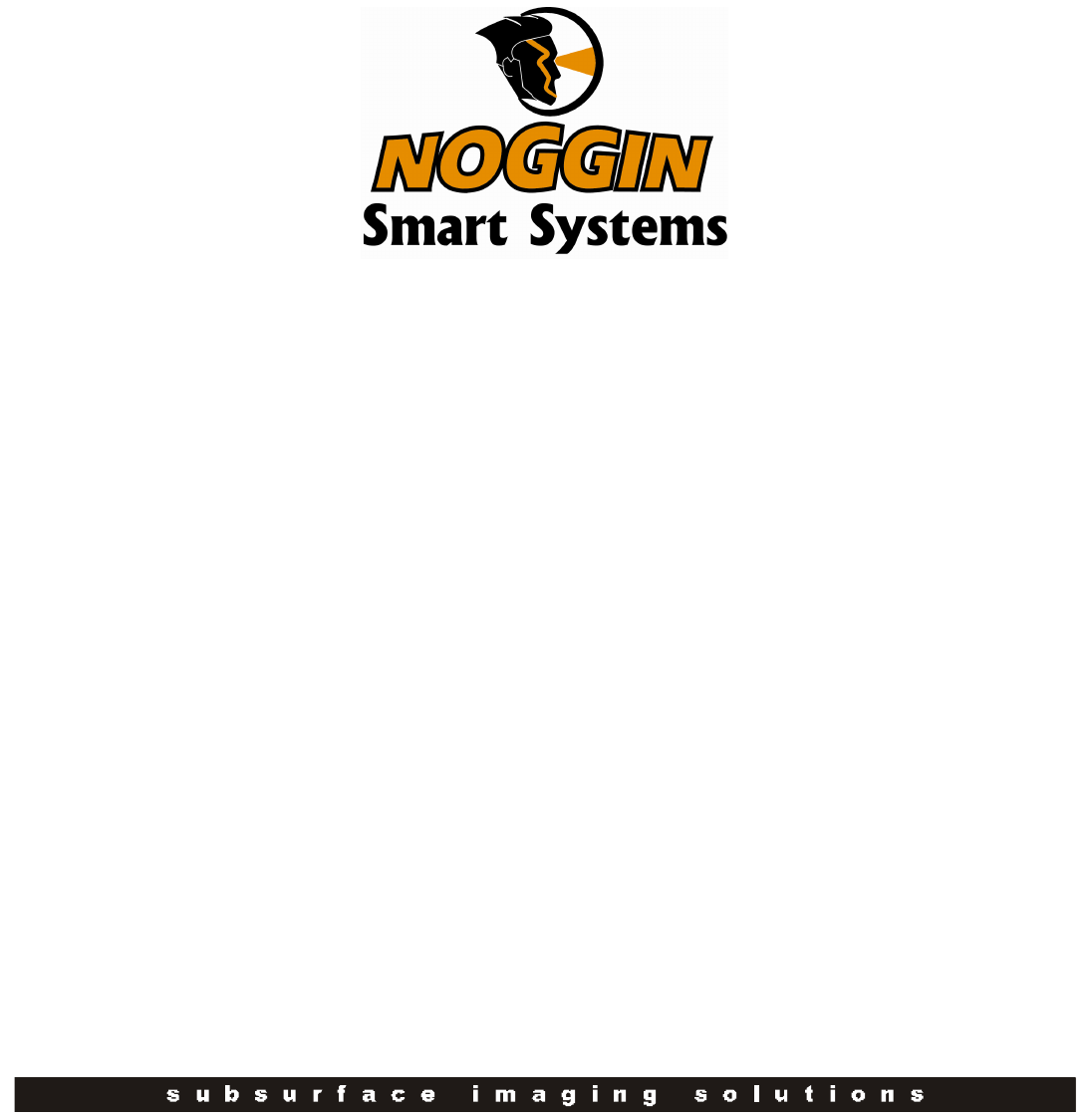
Users Manual Version 1.1

Smart Systems User’s Manual Version 1.1
ii

Smart Systems User’s Manual Version 1.1
iii
Information on pulseEKKO, Noggin and Conquest Products Regarding
Electromagnetic Emissions
Emissions
All governments have regulations on the level of electromagnetic emissions that an
electronic apparatus can emit. The objective is to assure that one apparatus or device
does not interfere with any other apparatus or device in such a way as to make the other
apparatus non-functional.
Sensors & Software Inc. have extensively tested their pulseEKKO, Noggin and
Conquest subsurface imaging products using independent testing houses and comply
with the regulations of the USA, Canada, European Community and other major
jurisdictions on the matter of emissions.
Not all electronic devices have been designed for interference immunity. When placed
in close proximity to another device interference may occur. There has never been a
report of interference from GPR products to date. If you observe unusual behavior on
nearby devices while you are operating a pulseEKKO, Noggin or Conquest product,
immediately turn off the product. You can test the cause and affect between the product
and the device if the disturbance starts and stops when the product is powered up and
shut off. If interference is confirmed, stop using the product.
Immunity
Immunity regulations place the onus on instrument/apparatus/device manufacturers to
assure that extraneous interference will not unduly cause an
instrument/apparatus/device to stop functioning or to function in a faulty manner.
Based on independent testing house measurements, Sensors & Software Inc. systems
comply with such regulations in Canada, USA, European Community and most other
jurisdictions. One must remember that Sensors & Software Inc.’s products are designed
specifically to sense electromagnetic fields. External sources of electromagnetic fields
such as TV stations, radio stations and cell phones, can cause detectable signals that
may degrade the quality of the data that the products record and display.
Such interference is unavoidable but sensible survey practice and operation by an
experienced practitioner can minimize such problems. In some geographic areas
emissions from external sources may be so large as to preclude useful measurements.
Such conditions are readily recognized and accepted by the professional geophysical
community as a fundamental limitation of geophysical survey practice.
Health
The interaction of electromagnetic fields with humans is an evolving field of
epidemiology although one which creates sensational press headlines. Humans are
immersed daily in a sea of electromagnetic fields which cover a wide range of
frequencies. Systematic correlation between EM fields and human illness have only
been reported at very high powers (millions of times greater than any Sensors &
Software Inc. product) for military radar systems operating in the 5000 to 20,000 MHz
range where physical burning/heating (basically like a microwave oven) have been
reported.

Smart Systems User’s Manual Version 1.1
iv
Sensors & Software Inc. monitors the research in this area. To date, the power levels of
Sensors & Software Inc.’s products are so small as to be inconsequential compared to
other common sources. If you are happy that a cell phone is not hazardous, then
Sensors & Software Inc.’s product, being of much lower power, need be of little concern.
Also see Appendix B - Health & Safety Certification.
Safety
Concerns are expressed from time to time on the hazard of subsurface imaging products
being used near blasting caps and unexploded ordnance (UXO). Experience with
blasting caps indicates that the power of Sensors & Software Inc.’s products are not
sufficient to trigger blasting caps. Based on a conservative independent testing house
analysis, we recommend keeping the subsurface imaging transmitters at least 5 feet
(2m) from blasting cap leads as a precaution.
The UXO issue is more complex and standards on fuses do not exist for obvious
reasons. To date, no problems have been reported with any geophysical instrument
used for UXO. Since Proximity and vibration are also critical for UXO, the best advice is
to be cautious and understand the risks.

Smart Systems User’s Manual Version 1.1
v
Copyright and Warranty Information
Software Licence & Limited Warranty
Important: Please read this document carefully before removing the SOFTWARE PRODUCT diskettes
from their protective cover or assembling the HARDWARE PRODUCT. By removing the
diskettes or assembling the hardware, you are agreeing to become bound by the terms of
this agreement. If you do not agree to the terms of this agreement, promptly contact
Sensors & Software, Inc. at the address indicated at the end of this document.
Definition
The word PRODUCT as used herein defines any complete Sensors & Software, Inc. ground penetrating radar
system comprised of the HARDWARE PRODUCT and SOFTWARE PRODUCT.
SOFTWARE PRODUCT Licence Agreement
In order to preserve and protect its rights under the applicable laws, Sensors & Software, Inc. (hereafter SSI)
does not sell any rights to its software products. Rather, SSI grants the right to use its software, diskettes
and documentation (hereafter collectively called SOFTWARE PRODUCT) by means of a SOFTWARE PRODUCT
LICENCE. You acknowledge and agree that SSI retains worldwide title and rights to all its software and that
the PRODUCT contains proprietary materials protected under copyright, trademark and trade secret laws.
Grant of SOFTWARE PRODUCT Licence
In consideration of payment of the license fee which is part of the price you pay for this product and your
agreement to abide by the terms and conditions of this License Agreement, SSI grants to you, the Licensee,
a non-exclusive right to use the SOFTWARE PRODUCT under the following conditions:
You may:
• use the SOFTWARE PRODUCT on a single workstation owned, leased or otherwise controlled by you
• copy the SOFTWARE PRODUCT for backup purposes in support of your use of the product on a single
workstation
You may not:
• copy, distribute or sell copies of the SOFTWARE PRODUCT or accompanying written materials, including
modified or merged SOFTWARE PRODUCT to others
• sell, license, sublicense, assign or otherwise transfer this license to anyone without the prior written
consent of SSI
• modify, adapt, translate, decompile, disassemble or create derivative works based on the SOFTWARE
PRODUCT
Termination
This license is effective until terminated. You may terminate the license at any time by returning the PRODUCT
and all copies to SSI. The license will automatically terminate without notice by SSI if you fail to comply with
any terms or conditions of this agreement. Upon termination, you agree to return the SOFTWARE PRODU CT and
all copies to SSI.
Update Policy
SSI may create, from time to time, updated versions of its PRODUCT. At its option, SSI will make such
updates available to licensees who have paid the update fee.
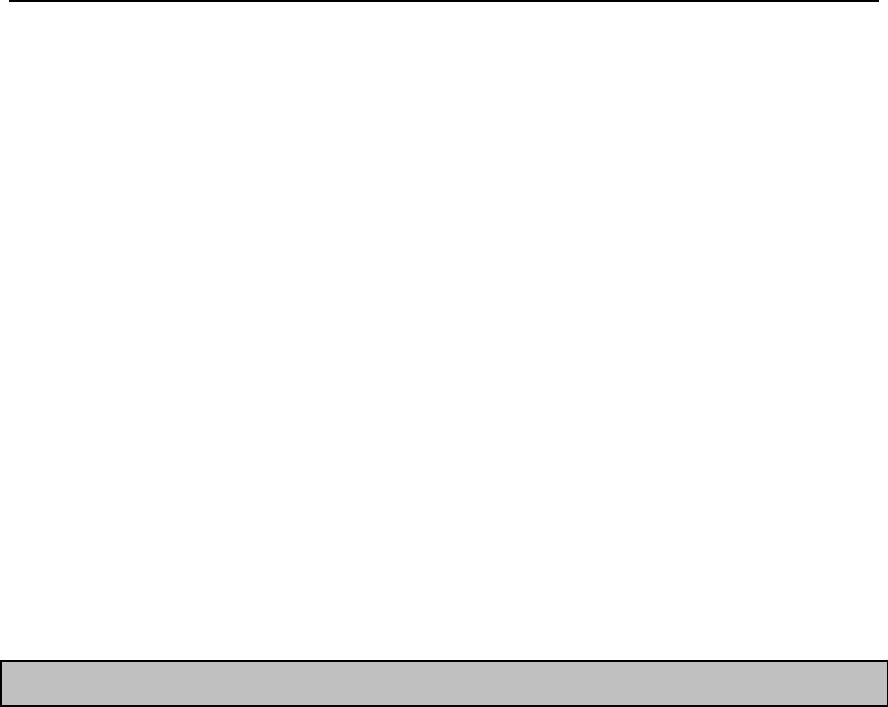
Smart Systems User’s Manual Version 1.1
vi
Product Limited Warranty
SSI warrants the HARDWARE PRODUCT to be free from defect in material and workmanship under normal use
for a period of ninety (90) days from the date of shipment. Any computer systems purchased with the
product are subject to the manufacturer's warranty and not the responsibility of SSI.
SSI warrants the diskettes on which the SOFTWARE PRODUCT is furnished to be free from defects in material
and workmanship under normal use for a period of ninety (90) days from the date of purchase as evidenced
by a copy of your invoice.
Except as specified above, the PRODUCT is provided "as is" without warranty of any kind, either expressed or
implied, including, but not limited to, the use or result of use of the product in terms of correctness, accuracy,
reliability, currentness or otherwise. The entire risk as to the results and performance of the PRODUCT is
assumed by you. If the PRODUCT is defective or used improperly, you, and not SSI or its dealers, distributors,
agents, or employees, assume the entire cost of all necessary servicing, repair or correction.
Limitation of Liability
SSI's entire liability and your exclusive remedy shall be, at SSI's opinion, either
• the replacement of any diskette or hardware components which do not meet SSI's Limited Warranty and
which are returned to SSI postage prepaid with a copy of the receipt, or
• if SSI is unable to deliver a replacement diskette which is free of defects in material or workmanship,
Licensee may terminate this agreement and have the license fee refunded by returning all copies of the
SOFTWARE PRODUCT postage prepaid with a copy of the receipt.
If failure of the diskette or hardware component resulted from accident, abuse or misapplication, SSI shall
have no responsibility to replace the diskette, refund the license fee, or replace the hardware component.
NOTE: DO NOT TAMPER WITH UNIT. No user serviceable parts in unit. If tampering is evident,
warranty is void and null.
No oral or written information or advice given by SSI, its dealers, distributors, agents or employees shall
create a warranty or in any way increase the scope of this warranty and you may not rely on any such
information or advice.
Neither SSI or anyone else who has been involved in the creation, production or delivery of the PRODUCT
shall be liable for any direct, indirect, special, exemplary, incidental or consequential damages, claims or
actions including lost information, lost profits, or other damages arising out of the use or inability to use this
PRODUCT even if SSI has been advised of the possibility of such damages.
This warranty gives you specific rights. You may have other rights which vary from province to province,
territory to territory and certain limitations contained in this limited warranty may not apply to you.
General
pulseEKKO®, Noggin®, SpiView®, and SnowScan®, are registered trademarks of SSI. No right, license, or
interest to such trademarks is granted hereunder with the purchase of the PRODUCT or the SOFTWARE
PRODUCT license.
Governing Law
In the event of any conflict between any provision in this license agreement and limited warranty and any
applicable provincial legislation, the applicable provincial legislation takes precedence over the contravening
provision. This agreement shall be governed and construed in accordance with the laws of the Province of
Ontario, Canada.

Smart Systems User’s Manual Version 1.1
vii
Serviceability
Should any term of this agreement be declared void or not enforceable by any court of competent
jurisdiction, the remaining terms shall remain in full effect.
Waiver
Failure of either party to enforce any of its rights in this agreement or take action against any other party in
the event of a breach of this agreement shall not be considered a waiver of the right to subsequent
enforcement of its rights or actions in the event of subsequent breaches by the other party.
Acknowledgement
You acknowledge that you have read this agreement, understand it and agree to be bound by its terms and
conditions. You further agree that this agreement is the complete and exclusive statement of agreement
between the parties and supersedes all proposals or prior agreements oral or written between the parties
relating to the subject matter of this agreement.
Should you have any questions concerning this agreement, please contact in writing:
Sensors & Software Inc.
1091 Brevik Place
Mississauga, Ontario
Canada L4W 3R7
Tel:(905) 624-8909
Fax:(905) 624-9365
E-mail: radar@sensoft.ca
Noggin Smart Cart, Noggin, CartView and SpiView are trademarks of Sensors &
Software, Inc..

Smart Systems User’s Manual Version 1.1
viii

Smart Systems User’s Manual Version 1.1
ix
TABLE OF CONTENTS
1 GENERAL OVERVIEW...........................................................................................1
2 ASSEMBLING THE SMART CART......................................................................2
2.1 Configuring the Smart Cart to Carry a Different Noggin System..................................................10
3 ASSEMBLING THE SMART HANDLE SYSTEM.............................................11
3.1 Smart Handle .................................................................................................................................................12
3.2 Cabling.............................................................................................................................................................14
3.2.1 DVL to Sensor Cable ................................................................................................................................. 14
3.2.2 Odometer Cable .......................................................................................................................................... 15
3.2.3 Smart Grip Cable ........................................................................................................................................ 15
4 STARTING THE DIGITAL VIDEO LOGGER.....................................................16
4.1 Running a DVL Detached from a Smart System.................................................................................18
5 NOGGIN ...................................................................................................................19
5.1 Overview of Noggin Menu Options..........................................................................................................19
5.1.1 Run................................................................................................................................................................ 19
5.1.2 Demo ............................................................................................................................................................ 19
5.1.3 Noggin Setup .............................................................................................................................................. 19
5.1.4 Transfer All Buffers................................................................................................................................... 19
5.1.5 Delete All Buffers ...................................................................................................................................... 20
5.1.6 Upgrades...................................................................................................................................................... 20
5.1.7 Return ........................................................................................................................................................... 20
5.2 Noggin Screen Overview.............................................................................................................................21
5.2.1 Section A - Data Parameters .................................................................................................................... 22
5.2.2 Section B - Data Display........................................................................................................................... 22
Depth Lines ........................................................................................................................................................... 22
Battery Voltage Indicator.................................................................................................................................... 22
Start of Section Indicator.................................................................................................................................... 23
Fiducial Markers .................................................................................................................................................. 23
5.2.3 Section C - Menu........................................................................................................................................ 24
5.3 Noggin Menu Options..................................................................................................................................24
5.3.1 Exit ................................................................................................................................................................ 24
5.3.2 Print Menu................................................................................................................................................... 24
Printing Data to an attached Printer.................................................................................................................. 24
Transferring Data to an External PC................................................................................................................. 26
5.3.3 View Menu.................................................................................................................................................. 27
5.3.4 Calib. (Calibration) Menu......................................................................................................................... 27
Hyperbola Matching............................................................................................................................................ 27
Target of Known Depth ...................................................................................................................................... 29
Selecting a Media ................................................................................................................................................. 30

Smart Systems User’s Manual Version 1.1
x
Input a Velocity Value ........................................................................................................................................ 30
5.3.5 Depth Menu................................................................................................................................................. 31
5.3.6 Gain Menu................................................................................................................................................... 31
5.3.7 Start Menu................................................................................................................................................... 32
5.3.8 Stop Menu................................................................................................................................................... 33
5.4 Noggin Data Acquisition .............................................................................................................................34
5.4.1 Collecting Data using the Odometer....................................................................................................... 34
Reducing Data Quality by Moving too Fast.................................................................................................... 35
Backing up the System to Pinpoint Target Positions..................................................................................... 35
5.4.2 Collecting Data using Continuous Operation (No Odometer) ........................................................... 36
5.4.3 Saving Data ................................................................................................................................................. 36
5.4.4 Deleting Data .............................................................................................................................................. 36
5.4.5 Special Keys................................................................................................................................................ 37
5.4.6 Error Messages ........................................................................................................................................... 37
5.5 Noggin Setup..................................................................................................................................................38
5.5.1 Editing DVL Settings................................................................................................................................ 38
Default Settings.................................................................................................................................................... 38
Time and Date....................................................................................................................................................... 38
Save Data Mode ................................................................................................................................................... 38
Units Used............................................................................................................................................................. 38
Odometer Markers ............................................................................................................................................... 39
Odometer Calibration .......................................................................................................................................... 39
Cart Direction ....................................................................................................................................................... 40
Odometer Active .................................................................................................................................................. 40
Label Size .............................................................................................................................................................. 40
Noggin System ..................................................................................................................................................... 40
Station Interval ..................................................................................................................................................... 41
Station Interval ................................................................................................................................................ 42
Linear Gain ............................................................................................................................................................ 43
Arrow Reference .................................................................................................................................................. 44
Window Zooming ................................................................................................................................................ 44
GPS Setup Menu.................................................................................................................................................. 45
Mode.................................................................................................................................................................. 46
Baud Rate ......................................................................................................................................................... 47
Stop Bits............................................................................................................................................................ 47
Data Bits ........................................................................................................................................................... 47
Parity ................................................................................................................................................................. 47
End String......................................................................................................................................................... 48
System Test #1................................................................................................................................................. 48
System Test #2................................................................................................................................................. 49
Transfer Rate......................................................................................................................................................... 49
Reset Counter........................................................................................................................................................ 49
5.6 Noggin Buffer File Management...............................................................................................................50
5.6.1 Transferring all Buffer Files to an External Computer using the WinPXFER Program ............... 50
Connecting the Digital Video Logger to an External Computer.................................................................. 50
Installing and Running the WinPXFER Program........................................................................................... 51
Transferring Buffer Files .................................................................................................................................... 52
Parallel Port not bi-directional Error................................................................................................................. 52
Viewing SPI Files in SpiView on the External PC ........................................................................................ 53
5.6.2 Deleting all Buffer Files on the DVL ..................................................................................................... 53
5.7 Upgrades..........................................................................................................................................................53

Smart Systems User’s Manual Version 1.1
xi
5.8 Advanced Topics ...........................................................................................................................................54
5.8.1 How Depth is Determined ........................................................................................................................ 54
6 NOGGINPLUS............................................................................................................55
6.1 Overview of Nogginplus Menu Options.....................................................................................................55
6.1.1 Line............................................................................................................................................................... 55
6.1.2 Grid ............................................................................................................................................................... 55
6.1.3 Setup............................................................................................................................................................. 56
6.1.4 File Management........................................................................................................................................ 56
6.1.5 Run without Saving Data.......................................................................................................................... 56
6.1.6 Utilities......................................................................................................................................................... 56
6.1.7 Return ........................................................................................................................................................... 56
6.2 Nogginplus Data Acquisition ........................................................................................................................57
6.2.1 Replaying or Overwriting Data................................................................................................................ 58
6.2.2 Screen Overview ........................................................................................................................................ 58
6.2.3 Section A – Position Information............................................................................................................ 59
6.2.4 Section B - Data Display........................................................................................................................... 59
Depth Lines ........................................................................................................................................................... 59
Fiducial Markers .................................................................................................................................................. 59
6.2.5 Section C - Menu........................................................................................................................................ 60
6.2.6 Gain .............................................................................................................................................................. 60
6.2.7 Collecting Data using the Odometer....................................................................................................... 61
Reducing Data Quality by Moving too Fast.................................................................................................... 62
Backing up the Cart to Pinpoint Target Positions .......................................................................................... 62
6.2.8 Calib. (Calibration) Menu......................................................................................................................... 63
Hyperbola Matching............................................................................................................................................ 63
Target of Known Depth ...................................................................................................................................... 65
6.2.9 Error Messages ........................................................................................................................................... 66
6.3 Nogginplus Setup.............................................................................................................................................67
6.3.1 System Parameters ..................................................................................................................................... 67
Depth...................................................................................................................................................................... 67
Velocity.................................................................................................................................................................. 68
Depth Units ........................................................................................................................................................... 68
Noggin System ..................................................................................................................................................... 69
Stacks ..................................................................................................................................................................... 69
Linear Time Gain ................................................................................................................................................. 69
Position Units........................................................................................................................................................ 70
6.3.2 Cart Parameters .......................................................................................................................................... 70
Cart Direction ....................................................................................................................................................... 70
Odometer Active .................................................................................................................................................. 70
Auto Start............................................................................................................................................................... 70
Arrow Offset......................................................................................................................................................... 70
Trip Menu.............................................................................................................................................................. 71
Transfer Rate......................................................................................................................................................... 71
Odometer Number................................................................................................................................................ 71
6.3.3 Line Parameters .......................................................................................................................................... 72
Start Position......................................................................................................................................................... 72
Line Direction....................................................................................................................................................... 72
Station Interval ..................................................................................................................................................... 72
Station Interval ................................................................................................................................................ 74
6.3.4 Grid Parameters .......................................................................................................................................... 75
Grid Type............................................................................................................................................................... 75

Smart Systems User’s Manual Version 1.1
xii
X Lines Only - Forward ................................................................................................................................. 75
Y Lines Only - Forward ................................................................................................................................. 76
XY Lines - Forward ........................................................................................................................................ 76
Survey Format ...................................................................................................................................................... 77
X Lines Only – Forward and Reverse......................................................................................................... 77
Y Lines Only – Forward and Reverse......................................................................................................... 78
XY Lines – Forward and Reverse................................................................................................................ 78
Grid Dimensions .................................................................................................................................................. 79
Line Spacing ......................................................................................................................................................... 79
6.3.5 GPS Parameters .......................................................................................................................................... 80
Mode....................................................................................................................................................................... 81
Baud Rate .............................................................................................................................................................. 83
Stop Bits................................................................................................................................................................. 83
Data Bits ................................................................................................................................................................ 83
Parity ...................................................................................................................................................................... 83
End String.............................................................................................................................................................. 83
System Test #1................................................................................................................................................. 84
System Test #2................................................................................................................................................. 84
6.3.6 Set Defaults ................................................................................................................................................. 84
6.4 Nogginplus File Management.......................................................................................................................85
6.4.1 Transferring all Data Files to an External Computer using the WinPXFER Program................... 85
Connecting the Digital Video Logger to an External Computer.................................................................. 85
Installing the WinPXFER Program................................................................................................................... 85
Exporting Data to an External Computer......................................................................................................... 86
Parallel Port not bi-directional Error................................................................................................................. 87
Viewing Data Files on the External Computer............................................................................................... 88
6.4.2 Deleting Data on the DVL........................................................................................................................ 88
6.5 Nogginplus Utilities .........................................................................................................................................89
6.5.1 Time and Date............................................................................................................................................. 89
6.5.2 Odometer Calibration ................................................................................................................................ 89
6.5.3 Upgrade........................................................................................................................................................ 90
6.5.4 System Information.................................................................................................................................... 90
7 TROUBLESHOOTING...........................................................................................91
7.1 Power Supply.................................................................................................................................................91
7.2 System Communications.............................................................................................................................91
7.3 System Overheating......................................................................................................................................92
7.4 DVL Problem.................................................................................................................................................92
7.5 Noggin Problem.............................................................................................................................................93
7.6 Contacting Sensors & Software Inc.........................................................................................................93
8 CARE AND MAINTENANCE................................................................................94
8.1 Battery Care...................................................................................................................................................94
8.2 DVL Internal Battery...................................................................................................................................94

Smart Systems User’s Manual Version 1.1
xiii
8.3 Skid Pads .........................................................................................................................................................95
APPENDIX A NOGGINPLUS DATA FILE FORMAT.............................................A-1
APPENDIX B HEALTH AND SAFETY CERTIFICATION .................................B-1
APPENDIX C FCC REGULATIONS......................................................................C-1
APPENDIX D OPERATION OF SHUT OFF SWITCH........................................D-1
References

Smart Systems User’s Manual Version 1.1
xiv
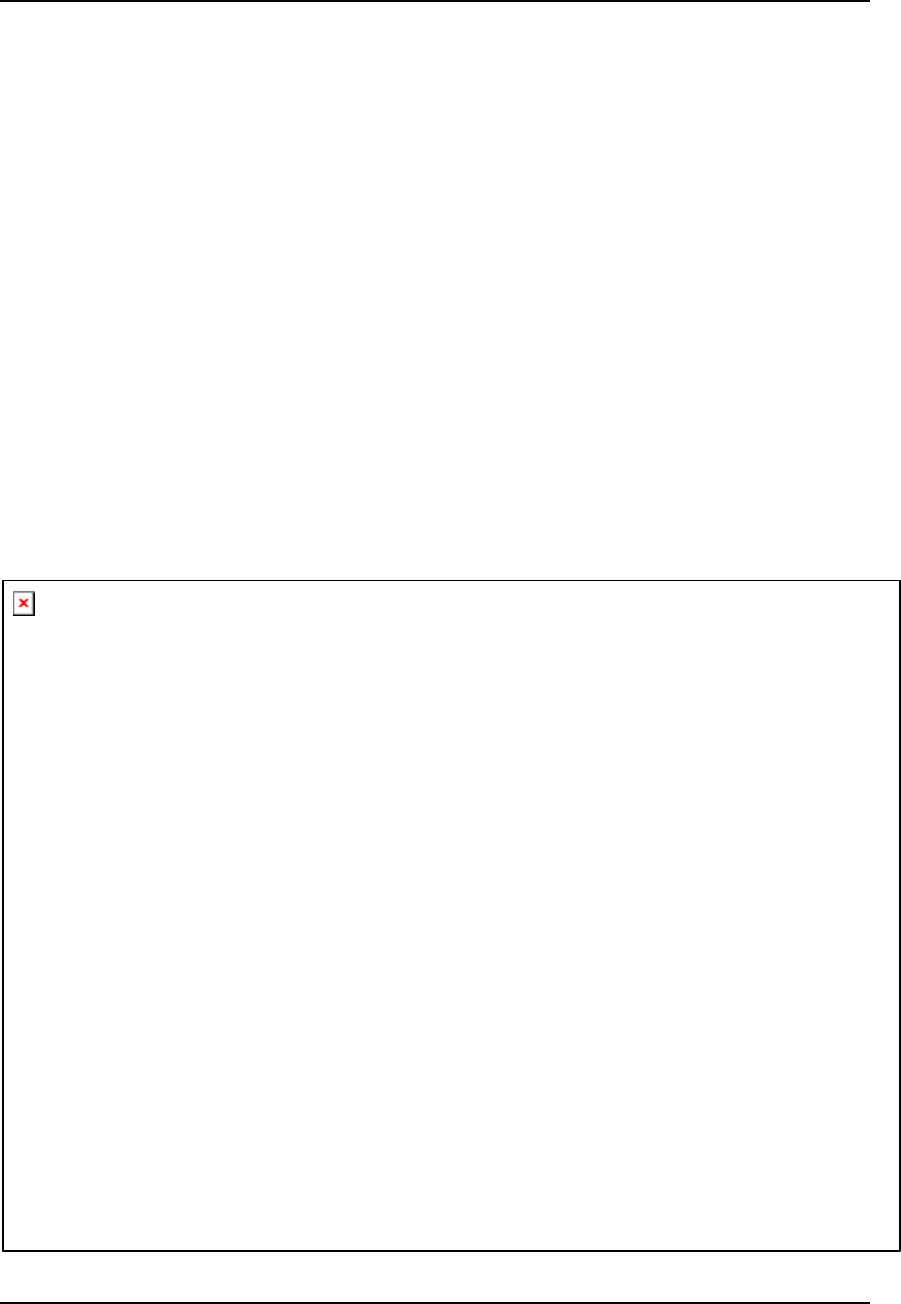
Smart Systems User’s Manual Version 1.1
1
1 General Overview
Noggin Smart Systems are integrated ground penetrating radar (GPR) data acquisition
platforms. Once the unit has been assembled and powered up you can be carrying out a
GPR survey in less than a minute. There are two different configurations available, the
Smart Cart system and the Smart Handle system (see Figure 1-1).
The Smart Cart system consists of the cart structure, a Noggin, an odometer wheel, a
digital video logger (DVL), and a battery. Section 2 describes how to assemble a Smart
Cart system.
The Smart Handle system consists of the Smart Handle, a Noggin, an odometer wheel,
a digital video logger (DVL), and a battery. Section 3 describes how to assemble a
Smart Handle system.
Each Smart System’s DVL comes with all the necessary software installed. This includes
software to acquire data as well as software to replay data files. Data management
software allows the data to be transferred to an external computer for further processing
and/or plotting.
Figure 1-1: Noggin Smart Cart system (left) and Noggin Smart Handle System (right).
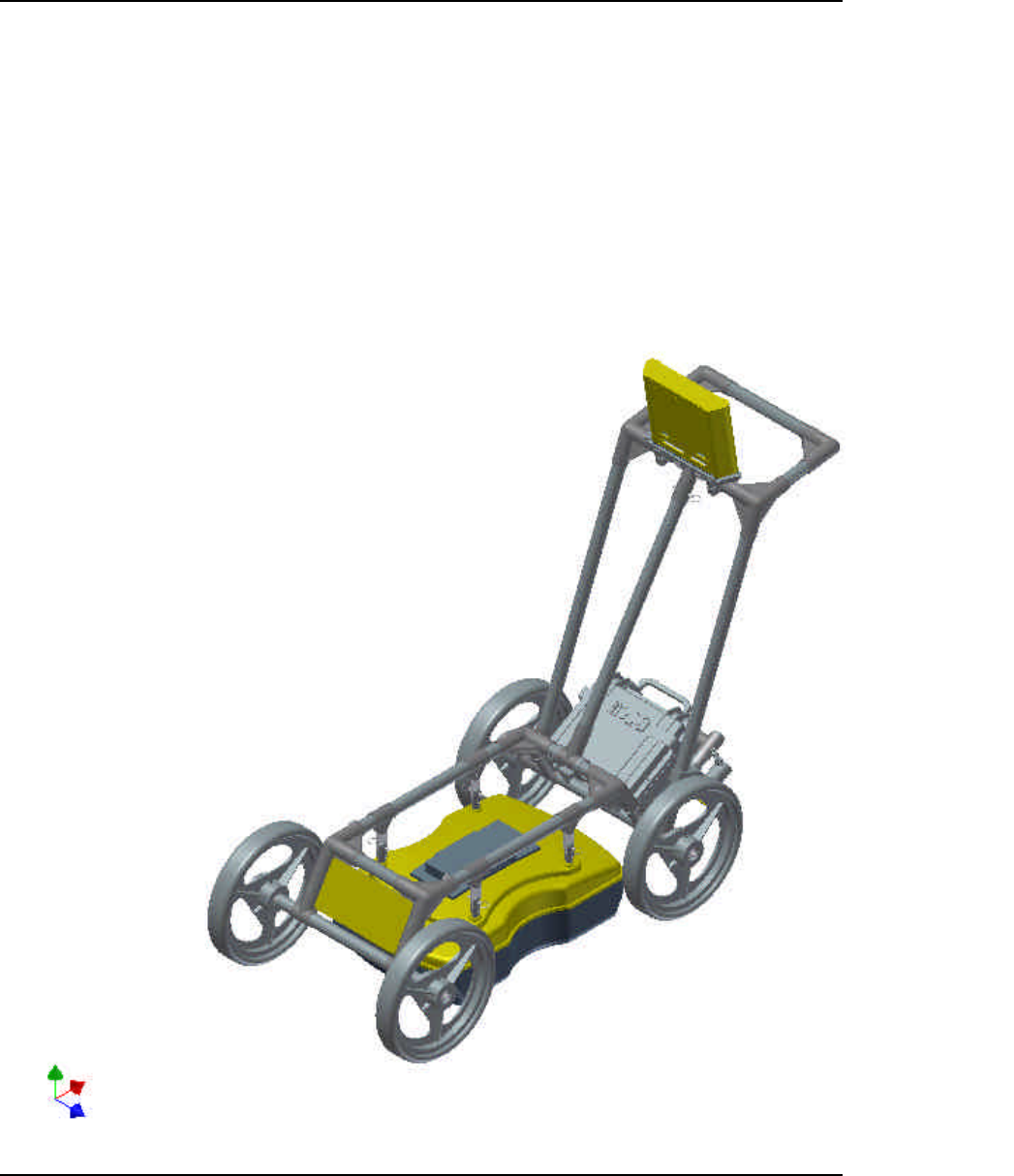
Smart Systems User’s Manual Version 1.1
2
2 Assembling the Smart Cart
The Noggin Smart Cart can be configured for Noggin 250, Noggin 500 or Noggin 1000
operation. For the Noggin 250 Smart Cart, refer to Figure 2-10. For the Noggin 500
Smart Cart, refer to Figure 2-11 and for the Noggin 1000 Smart Cart, refer to Figure
2-12.
Figure 2-1: Fully assembled Smart Cart
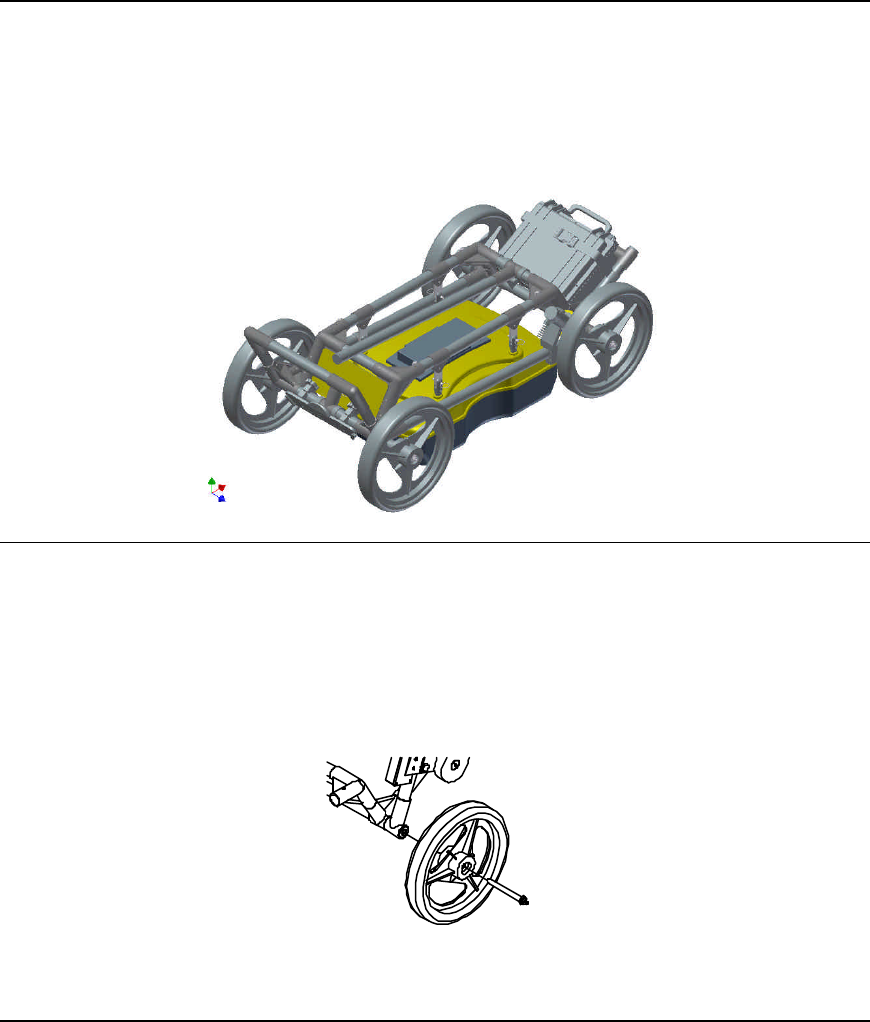
Smart Systems User’s Manual Version 1.1
3
The Noggin Smart Cart comes fully assembled but in collapsed position (Figure 2-2).
The steps necessary to have a fully functioning system are:
Figure 2-2: Smart Cart in collapsed position.
1. Attach wheels (if necessary): The Smart Cart may have been shipped without
the wheels attached or they may have been removed for storage. If this is the case, find
the axle for each wheel, press the button on the end of the axle, and insert the axle
through the wheel and into the cart frame. This is shown in Figure 2-3.
Figure 2-3: Attaching the wheel.
2. Unfold the Handle: Refer to Figure 2-4. Pull the ring to remove the handle
Clevis pin from the handle support arm. Raise the handle support arm and then the
handle and place the open end of the T-shaped tube on the handle onto the end of the
support arm (Step 1). Then lock the handle into position by lining up the hole in the
support arm with the hole in the T-shaped tube and inserting the handle Clevis pin (Step
2). (When folding the Smart Cart back up always ensure the handle folds down before
the handle support arm.)
With the system unfolded, make sure the small odometer wheel makes good contact
with the side of the cart wheel. If this contact is too loose, the odometer wheel may slip,
resulting in erroneous position measurements. If the odometer wheel seems loose, use
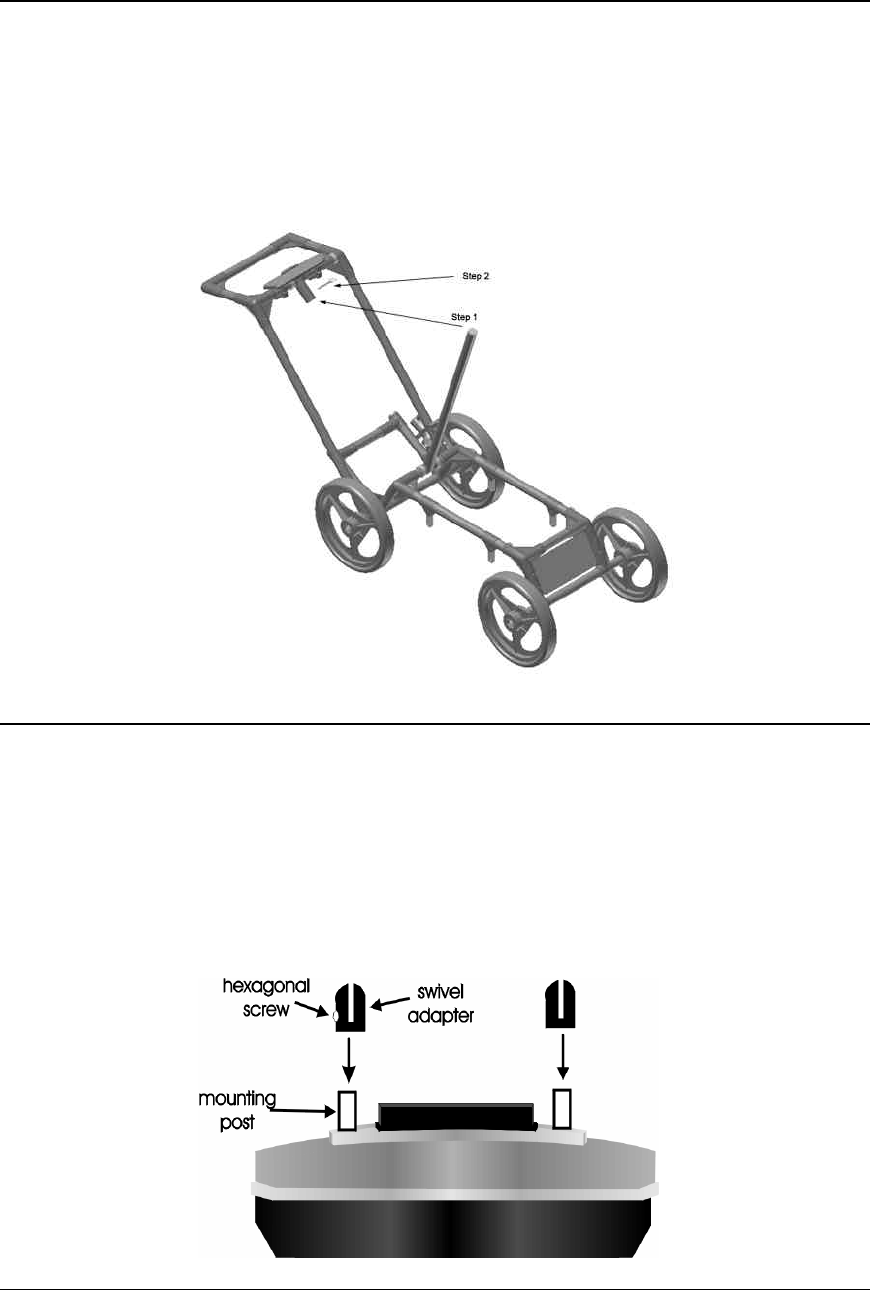
Smart Systems User’s Manual Version 1.1
4
a ¼ inch Allen (hexagonal) wrench to loosen the screws on the side of the odometer
(see Figure 2-10 or Figure 2-11) and pivot the entire odometer unit until the small
odometer wheel makes good contact with the side of the cart wheel. Then tighten the
screws to lock the odometer wheel in this position. After this has been done, it will be
necessary to re-calibrate the odometer (see Section 6.5.2).
Figure 2-4: Smart Cart set up.
3. Attach the Noggin: Before the Noggin unit can be attached to the Smart Cart,
the 4 swivel adapters (with attached Clevis pins) must be attached to the mounting posts
on the Noggin (see Figure 2-5). Set the swivel adapter down on the post. It may be
necessary to loosen the Allen (hexagonal) screw before the swivel adapter will slide
down into the proper position. This can be done using the 1/8” Allen (hexagonal) wrench
provided. Now, tighten each screw and then loosen ¼ turn so that the swivel adapters
are firmly attached to the post but can still rotate. DO NOT OVER-TIGHTEN!
Figure 2-5: Attaching the swivel adapters to the Noggin 250.
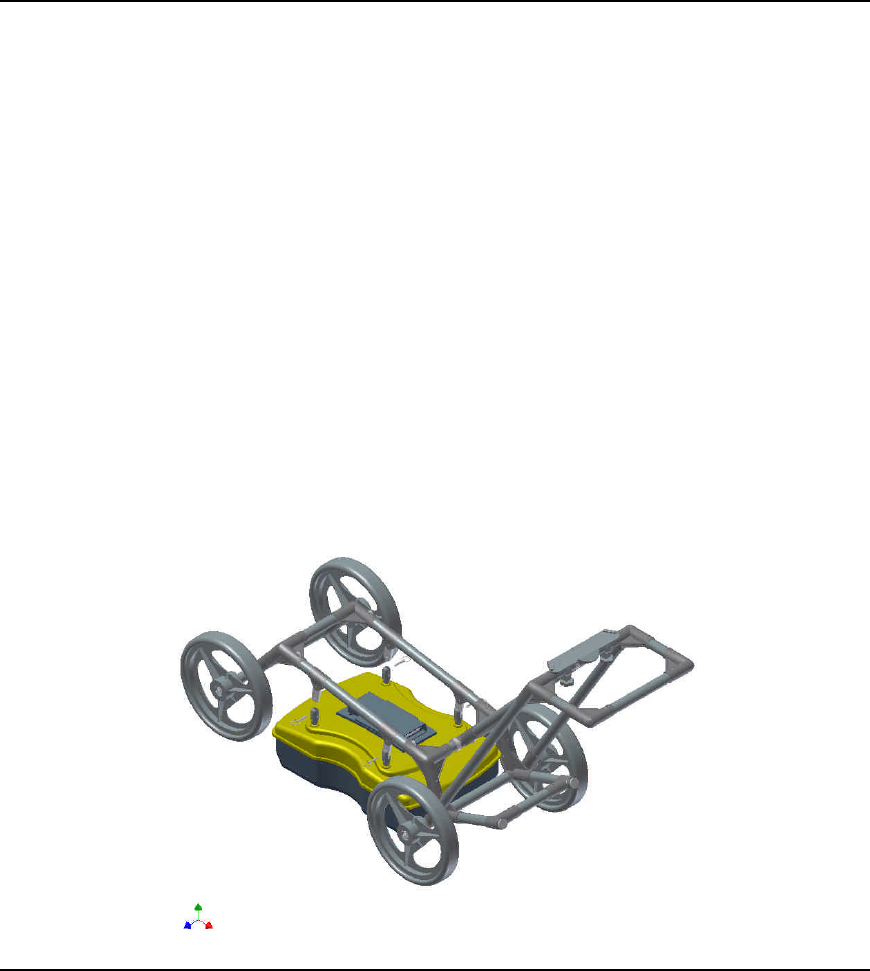
Smart Systems User’s Manual Version 1.1
5
Once all 4 swivel adapters are attached, the Noggin can then be attached to the Smart
Cart.
The Noggin is usually attached to the cart with the long axis of the Noggin unit parallel to
the wheels on the cart (see Figure 2-10 ,Figure 2-11 and Figure 2-12). For this
orientation, make sure the 37 socket female electrical receptacle on the Noggin faces
the back of the cart so that the cable on the cart will reach the receptacle.
It is also possible (but not usual) to attach the Noggin to the cart with the long axis of the
Noggin perpendicular (at right angles) to the wheels on the cart. For this orientation,
make sure the 37 socket female electrical receptacle on the Noggin is on the same side
of the cart as the odometer so that the cable on the cart will reach the receptacle.
Noggin 250: Remove the Clevis pins from the swivel adapters. Now, on the bottom of
the cart, locate the 4 oval, moveable hangers suspended from the frame of the cart (see
Figure 2-6). Notice that each hanger has a hole in it. To attach the Noggin 250 to the
cart, place each hanger into the slot on the top of the swivel adapters, line up the holes
and insert the Clevis pin.
Figure 2-6: Attaching the Noggin 250 to the cart.
Noggin 500 and Noggin 1000: Remove the Clevis pins from the swivel adapters. Now,
on the bottom of the cart, locate the two, flat, moveable crossbars suspended from the
frame of the cart. If the crossbars are attached, go to step B.
Step A: If the crossbars are detached from the cart, they will need to be attached before
attaching the Noggin to the cart (see Figure 2-7 top). To attach the cross bars, use the 4
oval, moveable hangers suspended from the frame of the cart. Insert the hanger into the
slot on the crossbar, line up the holes and insert the Clevis pin.
Step B: Notice that each crossbar has 2 holes, one on each side. To attach the Noggin
500 to the cart, place the crossbars into the slots on the top of the swivel adapters, line
up the holes and insert the Clevis pins.
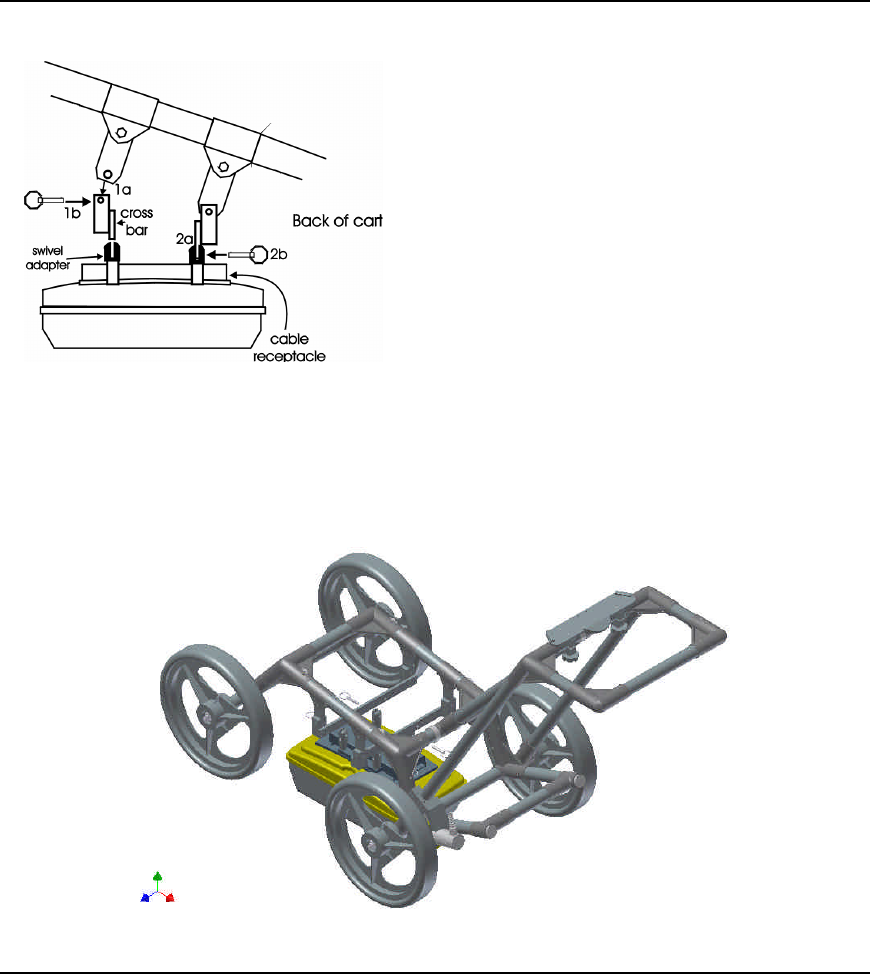
Smart Systems User’s Manual Version 1.1
6
Attach Cross bars to the cart (if
necessary).
a) Line up holes.
b) Insert Clevis pin.
Attach Noggin to cross bar.
a) Insert cross bar into swivel
adapter.
b) Insert Clevis pin.
Figure 2-7: Attaching the Noggin 500 and Noggin 1000 to the cart.
Connect the cable with the 37-pin male D connector to the Noggin and secure this
attachment by tightening the hand screws.
4. Attach the Digital Video Logger (DVL): The bottom of the Digital Video Logger
is designed to slide onto the support shelf attached to the Smart Cart (Figure 2-8). Line
up the bottom of the Digital Video Logger with the shelf and slide it back onto the shelf.
Push the Digital Video Logger back far enough so that the flexible clip on the front of the
shelf catches and holds the Digital Video Logger firmly in place. Wiggle the DVL to make
sure it is firmly snapped in before letting go of the unit. (To remove the Digital Video
Logger from the Smart Cart, this clip must be flexed downward as the DVL is slid
forward off of the shelf.
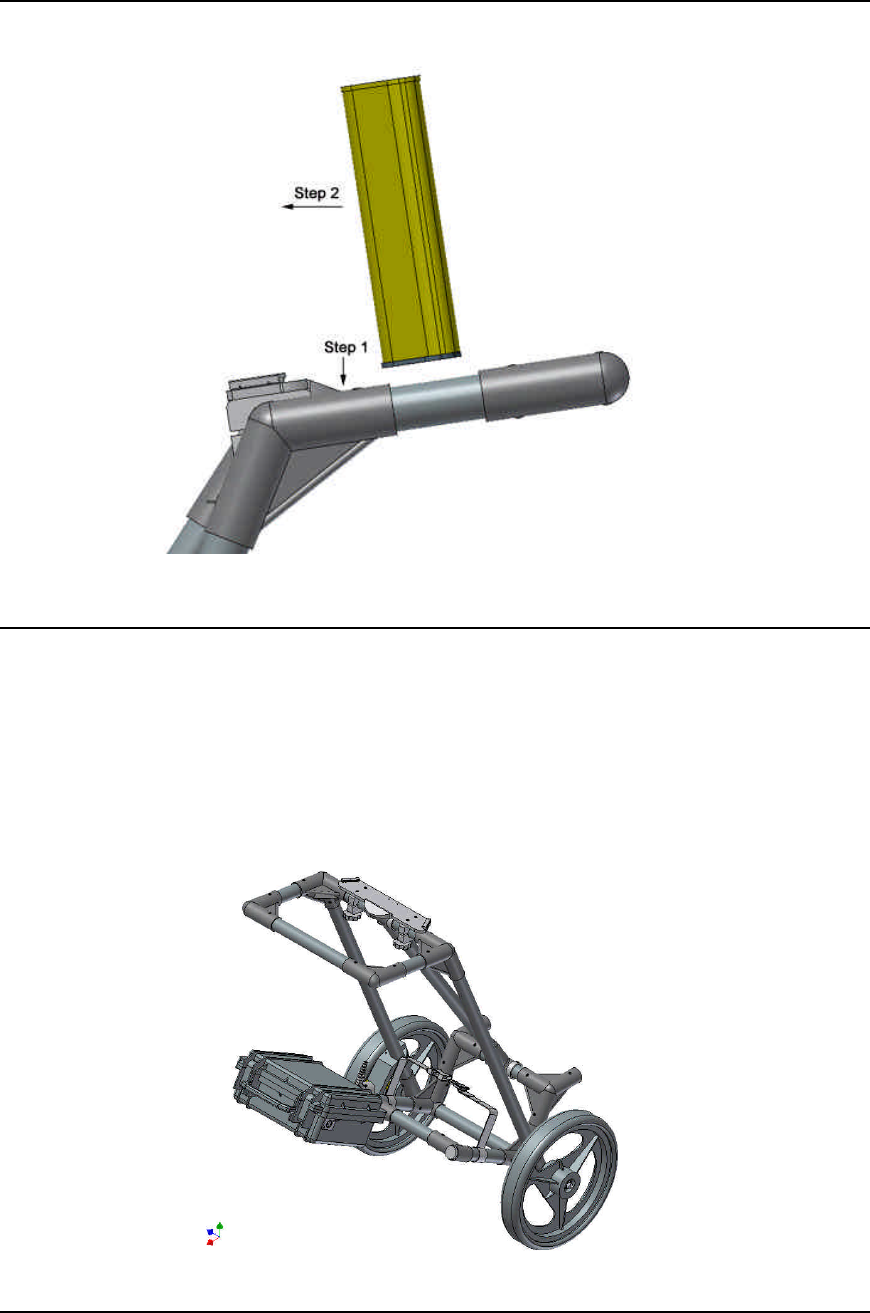
Smart Systems User’s Manual Version 1.1
7
Figure 2-8: Attaching the digital video logger (DVL). Step 1: Depress flexible clip. Step 2: Slide
DVL onto shelf.
Once the Digital Video Logger is in place, attach the cable with the 37-socket female D-
connector to the 37-pin receptacle on the back of the Digital Video Logger. This
attachment can be secured by tightening the hand screws.
The Digital Video Logger can be pivoted to adjust the view angle. If it is difficult to pivot
the Digital Video Logger, slightly loosen the hand screws on the bottom of the support
shelf.
Figure 2-9: The Noggin Smart Cart battery.
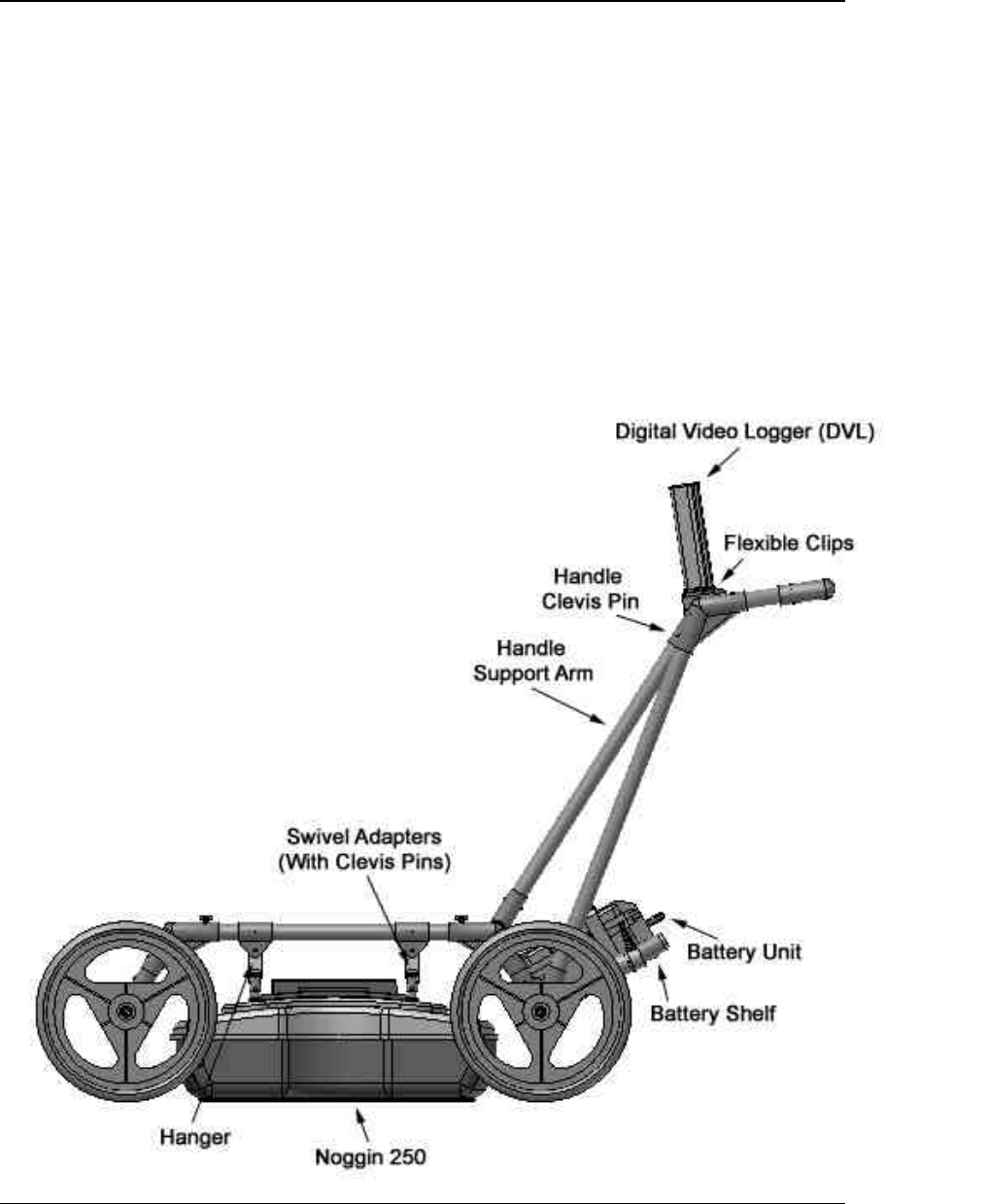
Smart Systems User’s Manual Version 1.1
8
5. Attach the Battery Unit: Set the battery unit onto the lower inclined shelf on the
back of the Smart Cart (see Figure 2-9). The handle on the battery unit should be
accessible from the back of the cart with the cable receptacle on the right. The battery
unit should rest in this area without moving. To secure the battery onto the cart, put the
straps provided over the battery unit and lock into place with the plastic buckle. Tighten
the straps if necessary.
With the Noggin Smart Cart completely assembled, connect the round 4-pin battery
cable to the receptacle on the side of the battery.
Note the battery mass forms part of the overall cart balance which enables users to raise
the front wheels with a minimum amount of force. This allows users to easily change
direction and assure the rear wheels are always in contact with the ground.
Figure 2-10: Noggin 250 Smart Cart
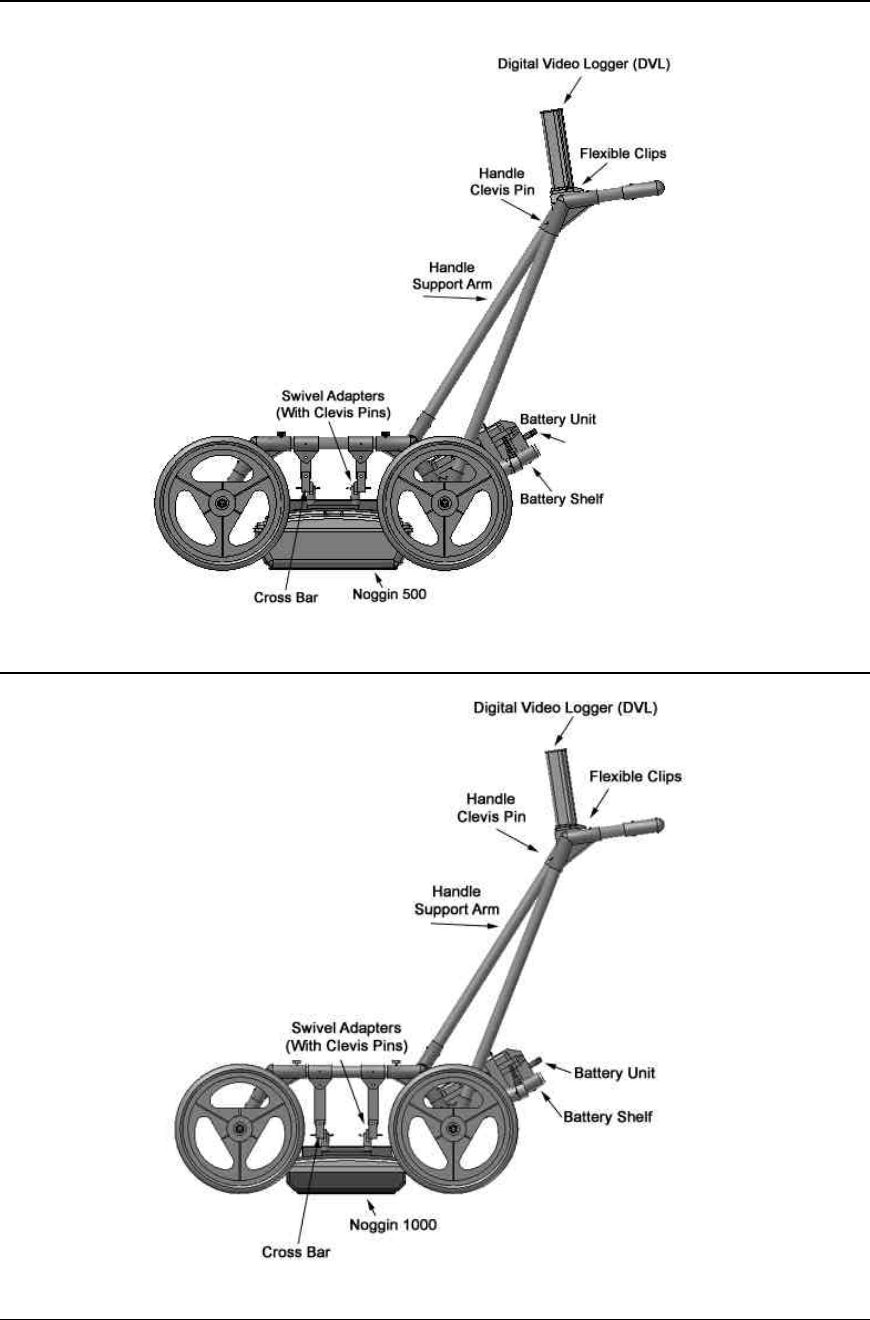
Smart Systems User’s Manual Version 1.1
9
Figure 2-11: Noggin 500 Smart Cart
Figure 2-12: Noggin 1000 Smart Cart
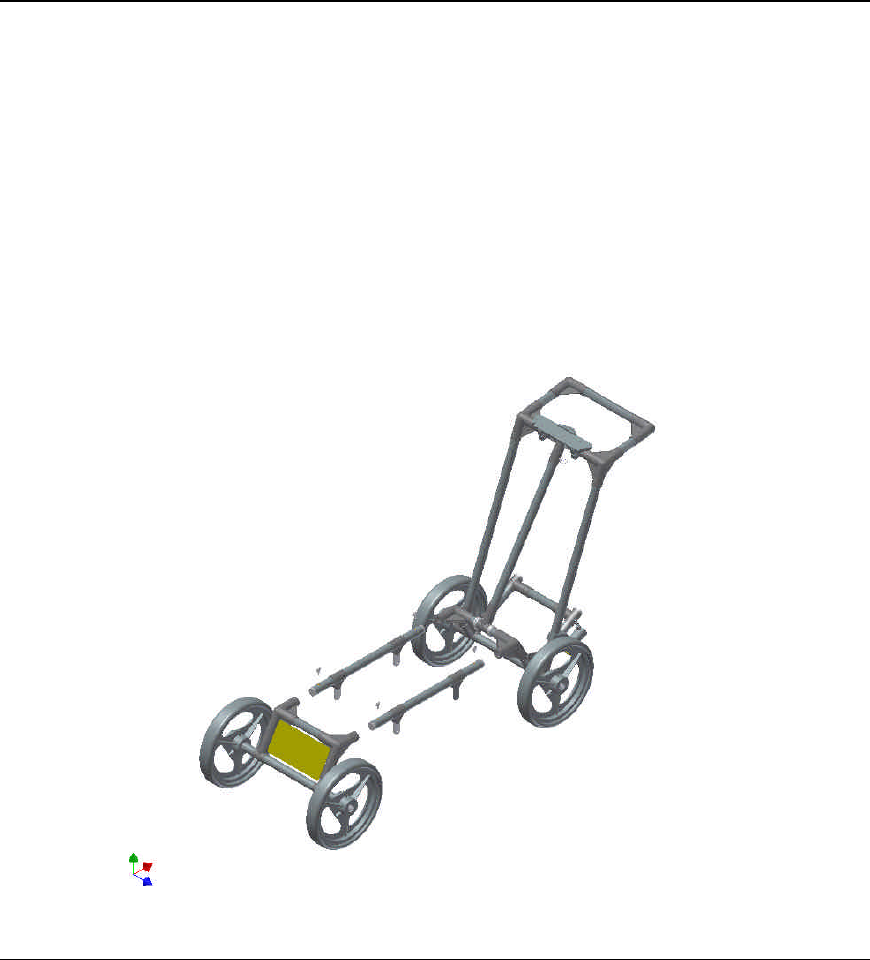
Smart Systems User’s Manual Version 1.1
10
2.1 Configuring the Smart Cart to Carry a Different
Noggin System
The Noggin Smart Cart can be configured to carry a Noggin 250, Noggin 500 or a
Noggin 1000 system. This can be done by replacing the two support arms on the cart
(see Figure 2-13) with the support arms for another system. Each arm is attached to the
cart by two hand screws. For each arm, remove the screws, detach the arm from the
cart and replace it with the new arm.
Figure 2-13: Changing the Smart Cart’s support arms to carry a different Noggin system.
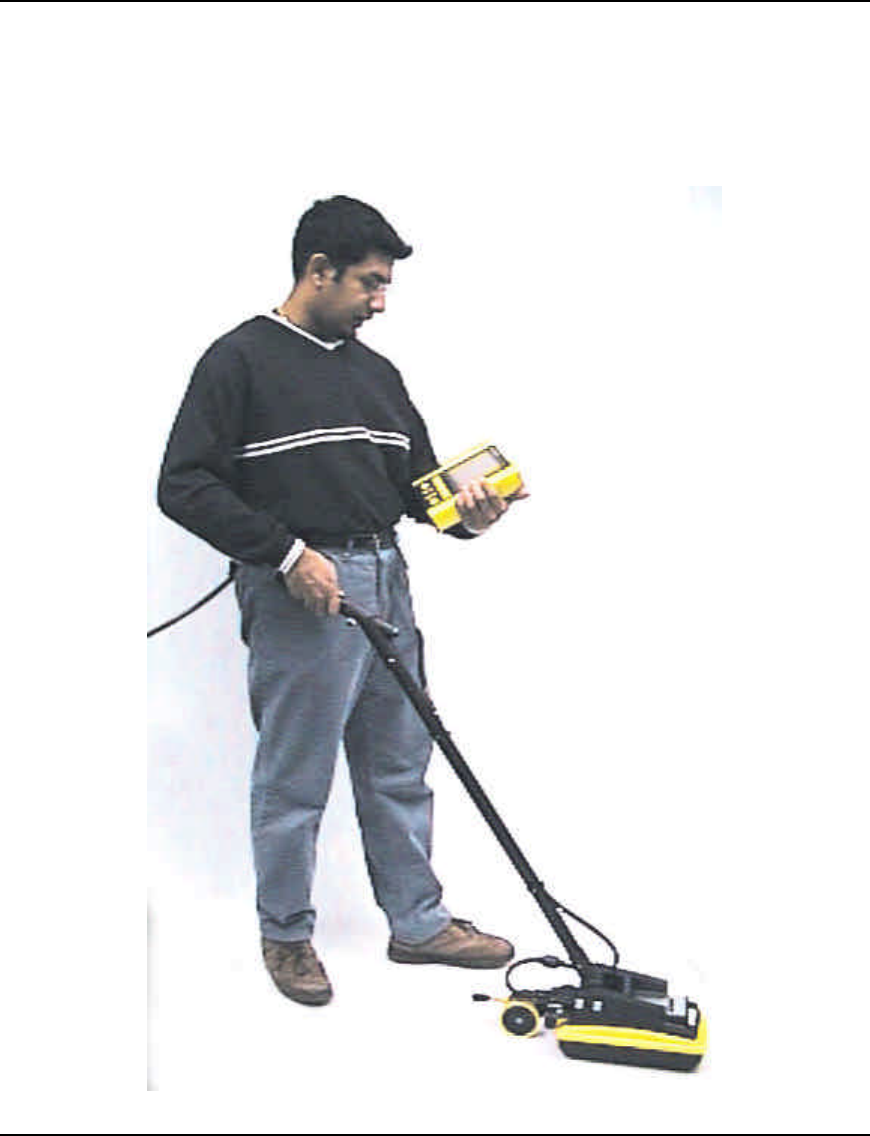
Smart Systems User’s Manual Version 1.1
11
3 Assembling the Smart Handle System
Figure 3-1: Smart Handle System with a Noggin 1000
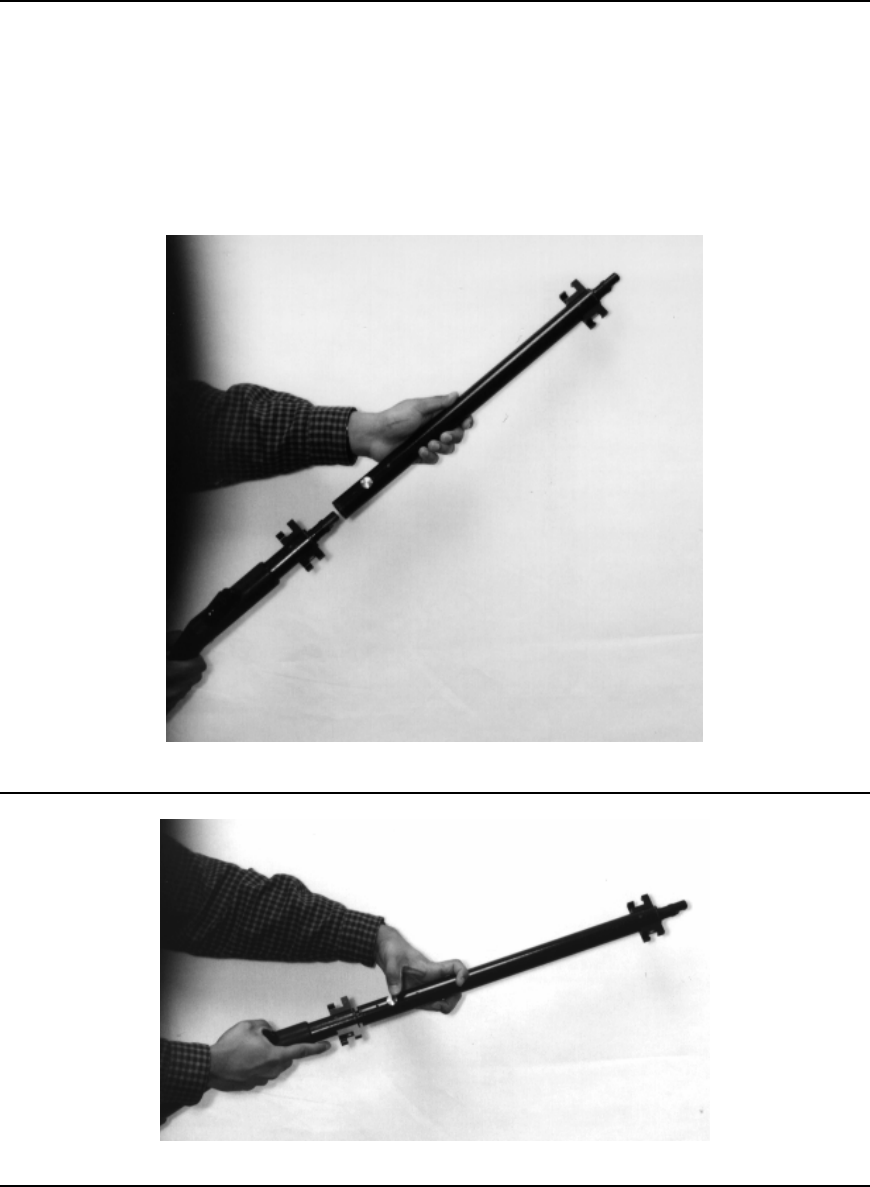
Smart Systems User’s Manual Version 1.1
12
3.1 Smart Handle
The Smart Handle consists of the Smart Handle grip and Smart Handle extension.
These two pieces are put together (see Figure 3-2 and Figure 3-3) and then attached to
the Noggin (see Figure 3-4). The system can be deployed without the handle extension
as shown in Figure 3-5 and Figure 3-6.
Figure 3-2: Simply push the Smart Handle grip into the Smart Handle extension
Figure 3-3: To separate them, push on the large grey button on the extension and pull them apart
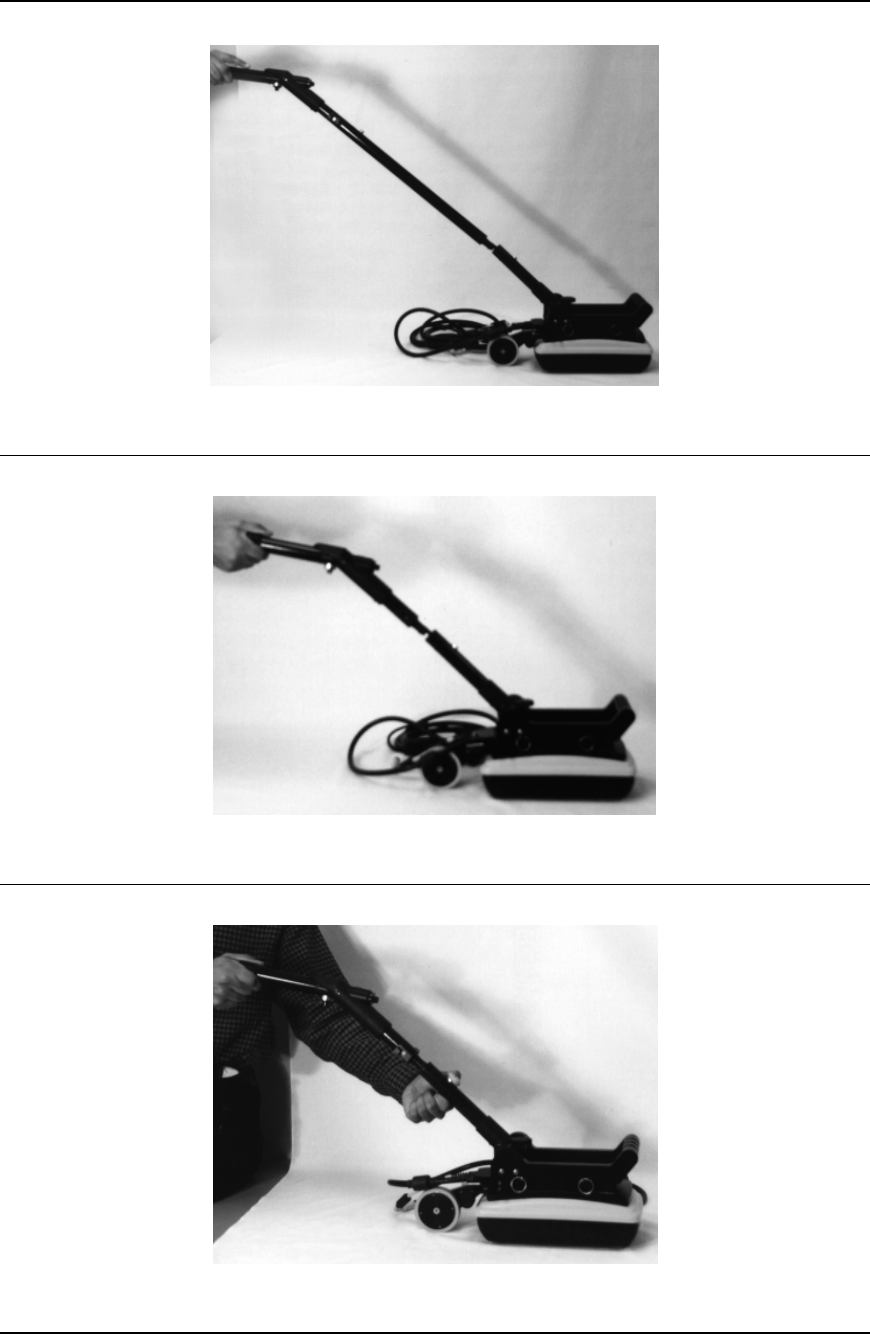
Smart Systems User’s Manual Version 1.1
13
Figure 3-4: Now connect the other end of the Smart Handle extension to the Noggin by simply
pushing it in.
Figure 3-5: For wall and ceiling scans in tunnels, it may be easier to just connect the Smart
Handle grip to the Noggin without the extension.
Figure 3-6: To separate either the short or long handle from the Noggin, press on the large grey
button on the pole extending from the Noggin and pull apart.
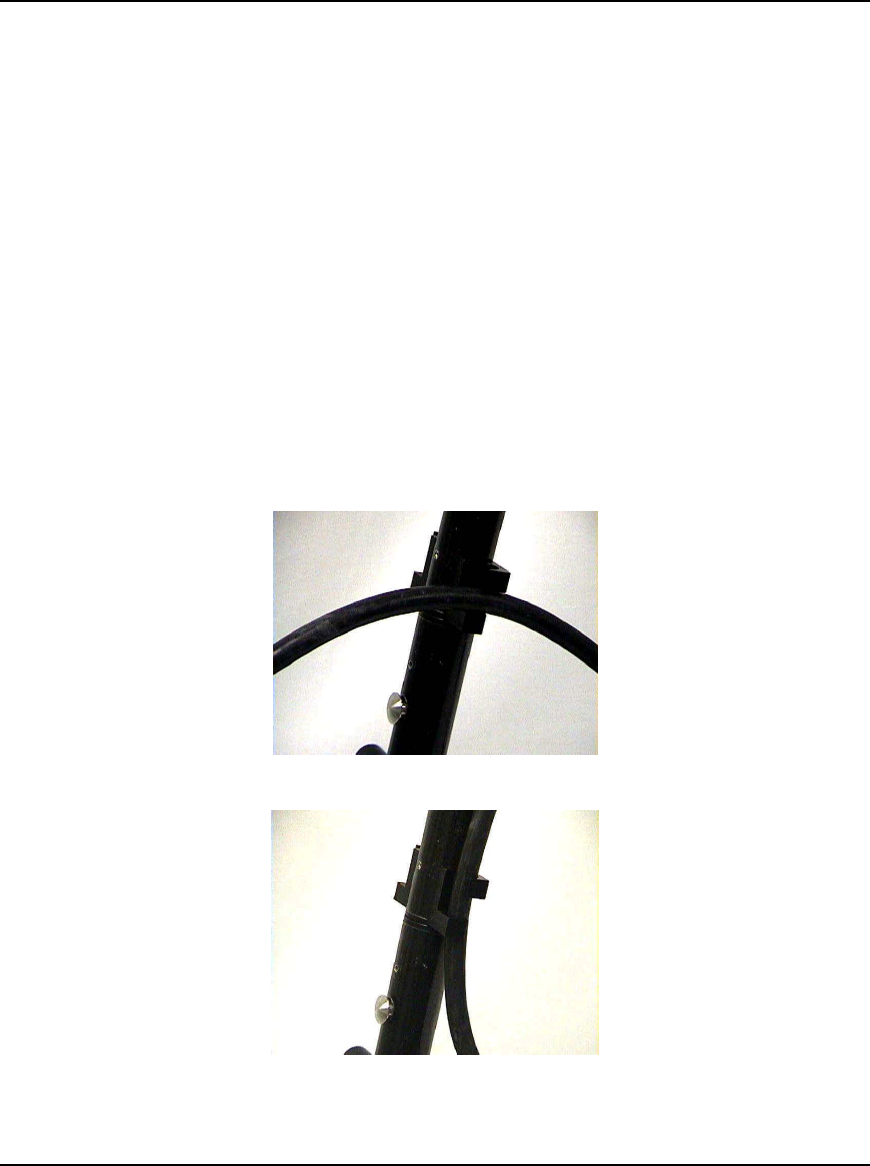
Smart Systems User’s Manual Version 1.1
14
3.2 Cabling
3.2.1 DVL to Sensor Cable
The DVL to Noggin cable is a Y-shaped cable with 3 connections; one to the Noggin
sensor, one to the DVL and one to the power supply (battery or AC).
Noggin Connection: The first connection is to attach the 37-pin connector on the cable
to the 37-socket connector on the Noggin. Use the thumb screws to secure this
connection.
From the Noggin, the DVL to Sensor Cable runs up the side of the Smart Handle. Use
the guides (clips) on the side of the Smart Handle to attach the cable to it (see Figure
3-7).
(a)
(b)
Figure 3-7: a) Insert cable - b) twist to grip
DVL Connection: The second connection from the DVL to Sensor Cable is to the DVL.
One end of the Y-shaped cable has a 37 socket connector. This end plugs into the 37-
pin connector on the back of the DVL.
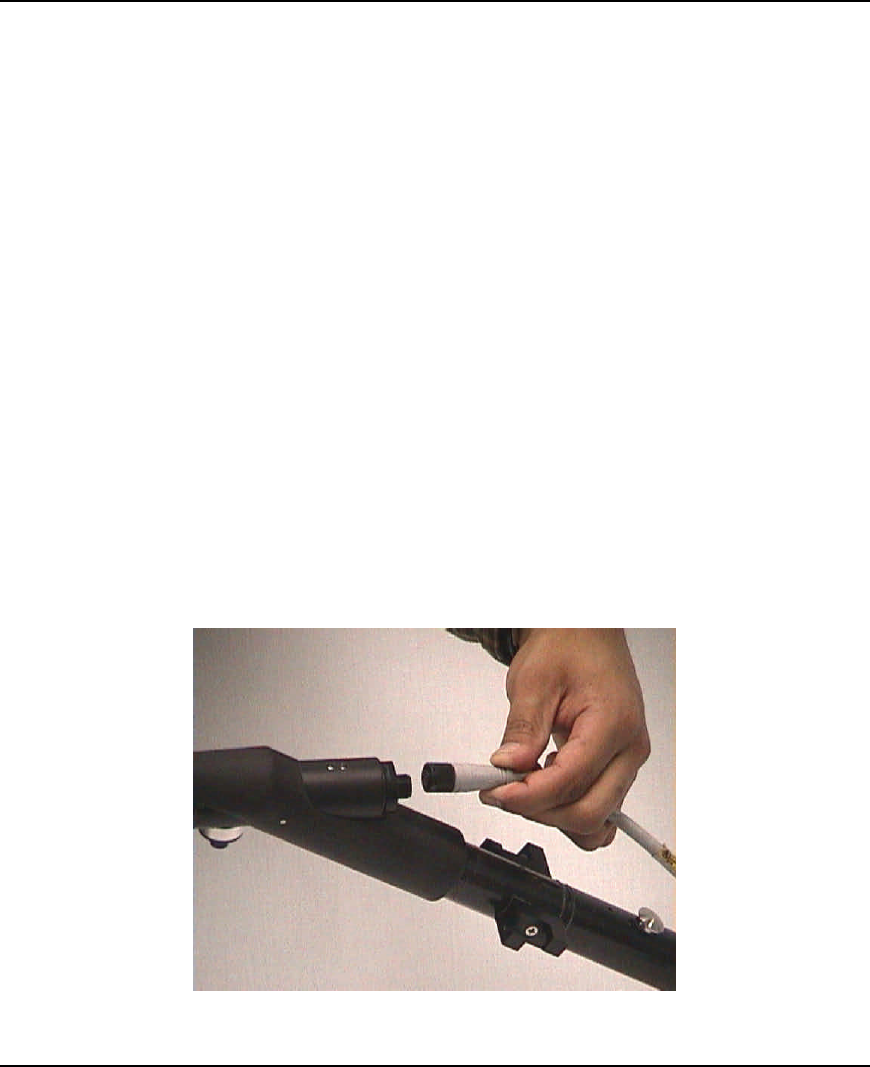
Smart Systems User’s Manual Version 1.1
15
Power Connection: The third connection on the Smart Handle cable attaches to a
power supply. The round, 4-pin connector attaches to either the standard battery or
optional AC adapter.
3.2.2 Odometer Cable
The cable connecting the odometer or positioning wheel comes already installed at the
factory.
3.2.3 Smart Grip Cable
The Smart Grip Cable is used to connect the Smart Handle button and beeper into the
system. The Smart Grip Cable is a light grey, two part cable (pre-assembled) that
connects from the Noggin to the end of the Smart Handle grip. The connection at the
Noggin may already be made when the system is pulled from the box. The other end of
the cable attaches to the connector at the bend of the Smart Handle grip (see Figure
3-8). Again, this cable can run up the side of the Smart Handle using the guides (clips) to
secure the cable to it.
Figure 3-8: The Smart Grip Cable attaches to the end of the Smart Handle Grip. This connects
the Smart Handle button (extreme left, bottom) and beeper (not shown) into the system.
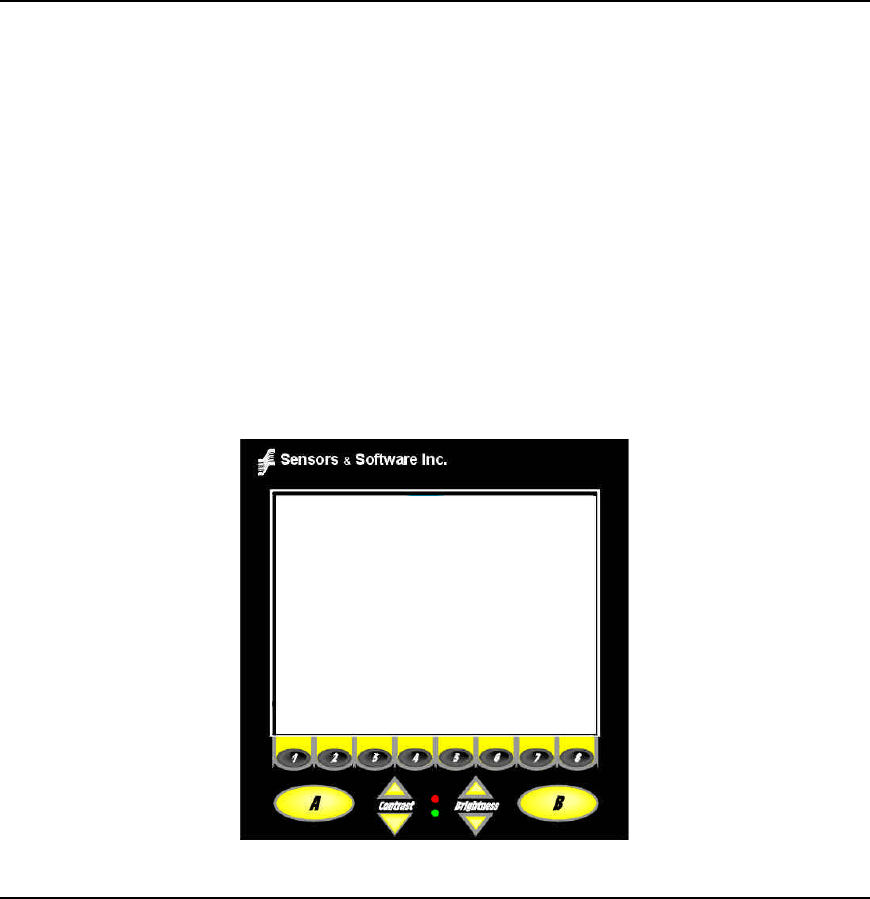
Smart Systems User’s Manual Version 1.1
16
4 Starting the Digital Video Logger
Once all the cable connections are made between the Noggin, the Digital Video Logger
(DVL) and the battery, the upper red LED light on the DVL panel should be lit. If the
battery voltage is low, the light will flash for about 30 seconds and go out. If the light
flashes or does not appear, check the connections and make sure the battery is fully
charged. (See Section 8.1 for more information on battery care.)
The voltage indicator can be helpful for identifying when the battery needs to be
recharged. If the battery voltage drops too low the DVL will cease to operate.
The front of the DVL is shown in Figure 4-1. To start the system, press any button on
the front panel. The DVL will begin to beep indicating it is booting up. The lower red
LED on the front panel should illuminate.
Figure 4-1: Digital Video Logger (DVL) face
At this stage, the Noggin unit will still be powered down. Once Noggin action is
requested (see later menu items), the DVL will enable power to the Noggin. If the
Noggin is receiving power, the red LED light on the connector to the Noggin will be
illuminated.
The water-resistant membrane keypad has a number of buttons that can be pressed to
perform various tasks. Note that the buttons on the membrane keypad sometimes need
to be pressed hard to register.
Menu Buttons: The yellow buttons labelled 1 to 8 correspond to menu choices that
appear listed on the screen or along the bottom of the screen when the Digital Video
Logger is turned on.
In addition, there are two general-purpose buttons labeled A and B. All buttons are DVL
application dependent and roles change. The operation will be self-explanatory from the
display screen.

Smart Systems User’s Manual Version 1.1
17
Screen: The DVL screen is a grayscale LCD selected for its wide temperature range
and visibility in sunlight. Visibility can be a major problem with viewing GPR data
displays outdoors and considerable effort has been expended on getting a readily visible
outdoor display.
Brightness: The yellow Brightness control arrows are used to increase and decrease
the screen brightness. For example, increasing the Brightness setting may improve the
visibility of the screen when outside on a sunny day. Note, however, that increasing the
screen brightness also increases battery consumption so don’t use a bright screen
unless necessary.
Contrast: The yellow Contrast control arrows are used to increase and decrease the
screen contrast. For example, increasing the Contrast setting may improve the visibility
of weaker features on the screen. Adjusting the contrast has little effect on battery
consumption.
Temperature sensors within the DVL automatically compensate the screen setting so
that manual adjustments of Brightness and Contrast should seldom be needed after
initial setup.
Once the Digital Video Logger powers up, the Main Menu is displayed with 3 choices:
A – NOGGIN
B – NOGGIN PLUS
5 – POWER OFF
12.1 V 38°C Rev 3.00
100°F
• Pressing the A button starts the software for standard Noggin systems. Details about
the Noggin system software can be found in Section 5.
• Pressing the B button starts the software for Nogginplus systems. Details about the
Nogginplus system software can be found in Section 6.
• Pressing the 5 button will turn the DVL off.
• Note that Nogginplus systems will operate with both the Noggin and Nogginplus
software while standard Noggin systems will only operate with the Noggin
software.
This screen also displays the following information:
• Battery Voltage: The system will shut down when the battery voltage reaches 10.2
Volts (see Section 8.1 for more details on the battery).
• Temperature: The internal temperature of the DVL is displayed on this screen in
Celsius and Fahrenheit.
• Software Version: The version of the software loaded on the DVL.
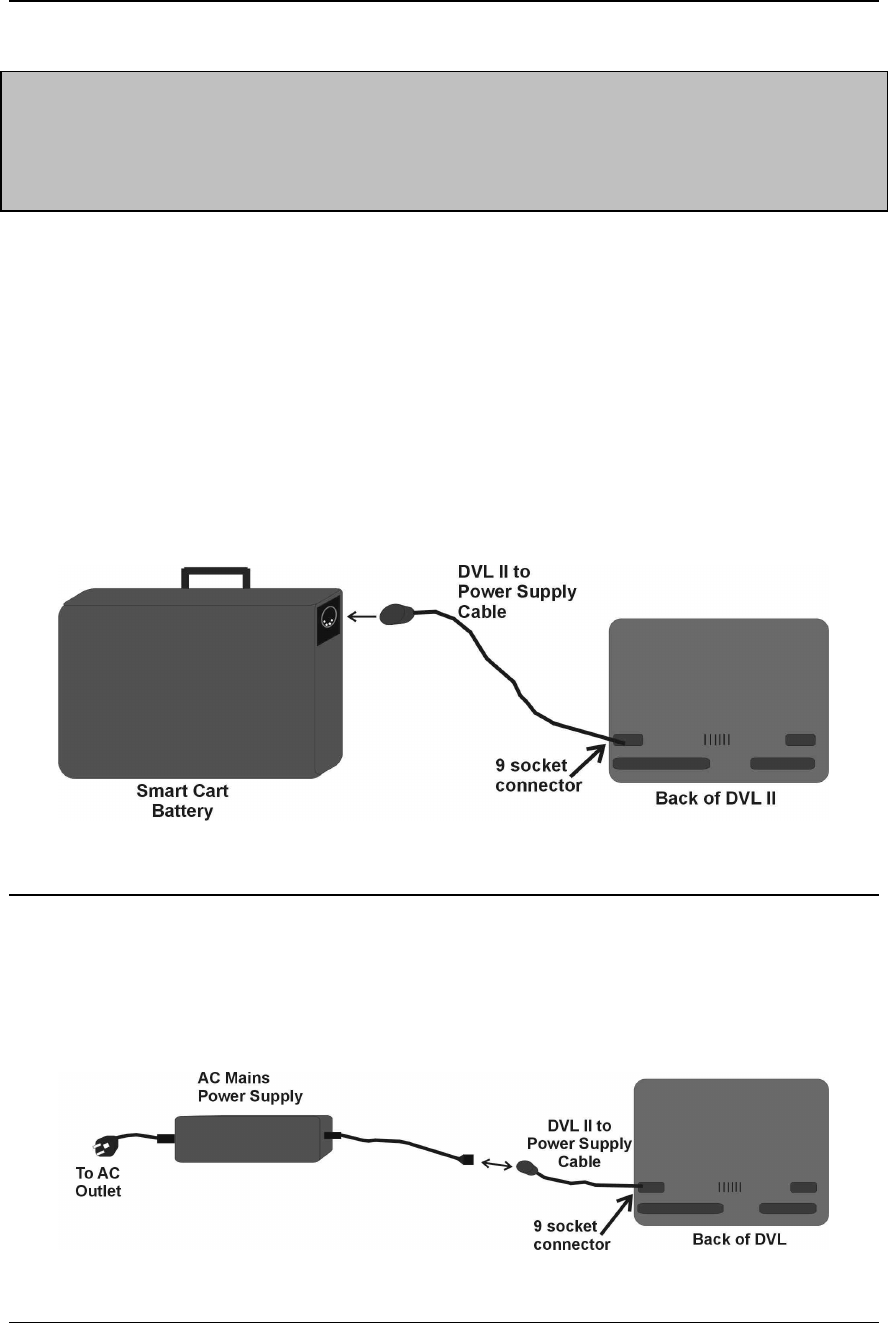
Smart Systems User’s Manual Version 1.1
18
When the Smart Cart is not being used, do not leave the
battery plugged in. The system draws about 0.1 amps even
when it is powered off and this will gradually drain the
battery.
4.1 Running a DVL Detached from a Smart System
When collecting data with a Smart System, the DVL is powered by the system battery. It
is possible to detach the DVL from the Smart Cart (see Figure 2-8) or the Smart Handle
system and use it away from the system to review, print or download data. There are 2
ways to power the DVL away from the Smart System and both involve using optional
accessories.
The optional DVL II to Power Supply Cable allows the user to power the DVL away from
the cart using the system battery. As shown in Figure 4-2, the cable connects the
battery to the 9-socket connector on the back of the DVL.
Figure 4-2: The optional DVL II to Power Supply cable can be used to power the Digital Video
Logger (DVL) from the system battery.
To avoid having to use the system battery to power the DVL, an optional AC power
supply is available. This, when combined with the DVL II to Power Supply Cable, allows
the user to power the DVL away from the cart using AC power. As shown in Figure 4-3,
the AC power supply connects to the DVL II to Power Supply Cable which connects to
the 9 socket connector on the back of the DVL.
Figure 4-3: The optional DVL II to Power Supply cable can be combined with an optional AC
power supply to power the Digital Video Logger (DVL) without the system battery.

Smart Systems User’s Manual Version 1.1
19
5 Noggin
5.1 Overview of Noggin Menu Options
The Noggin main menu has the following choices:
A – RUN
B – DEMO
1 – NOGGIN SETUP
2 – TRANSFER ALL BUFFERS
3 – DELETE ALL BUFFERS
4 – UPGRADES
7 – RETURN
12.1 V Rev 6.00
5.1.1 Run
Pressing the A button starts the Noggin data acquisition program (see Section 5.4).
5.1.2 Demo
Pressing the B button starts the Noggin Demonstration program. This program simulates
data acquisition (without actually moving the cart) by displaying a default data set. This
data set cycles continuously until the user exits from the demo program. This allows the
user to see and experiment with the different menu items and different settings to see
the effect they have on the data presentation.
It is useful to run the demonstration program while reviewing the Noggin Screen
Overview described in Section 5.2 and Noggin Menu Options described in Section 5.3.
5.1.3 Noggin Setup
There are many background setup parameters related to the Noggin Smart Cart
operation that can be edited. This menu allows the user to display and change various
settings for different aspects of the Smart Cart system. The user can also reset all the
parameters to the factory default settings. See Section 5.5 – Default Settings.
5.1.4 Transfer All Buffers
Pressing the number 2 on the main menu transfers ALL the data buffers (up to 250
screens) from the DVL to an external PC. See Section 5.6.1.

Smart Systems User’s Manual Version 1.1
20
5.1.5 Delete All Buffers
Pressing the number 3 on the main menu allows the user to delete ALL the data buffers
currently saved on the DVL. See Section 5.6.2
5.1.6 Upgrades
Pressing the number 4 on the main menu puts the DVL into listen mode to allow a
software upgrade to be transferred from an external PC to the DVL. Avoid pressing this
button until the instructions in a software upgrade tell you to. Once pressed, the DVL
must be powered down exit from this menu item. See Section 5.7.
5.1.7 Return
This button will return the user to main menu. See Section 4.
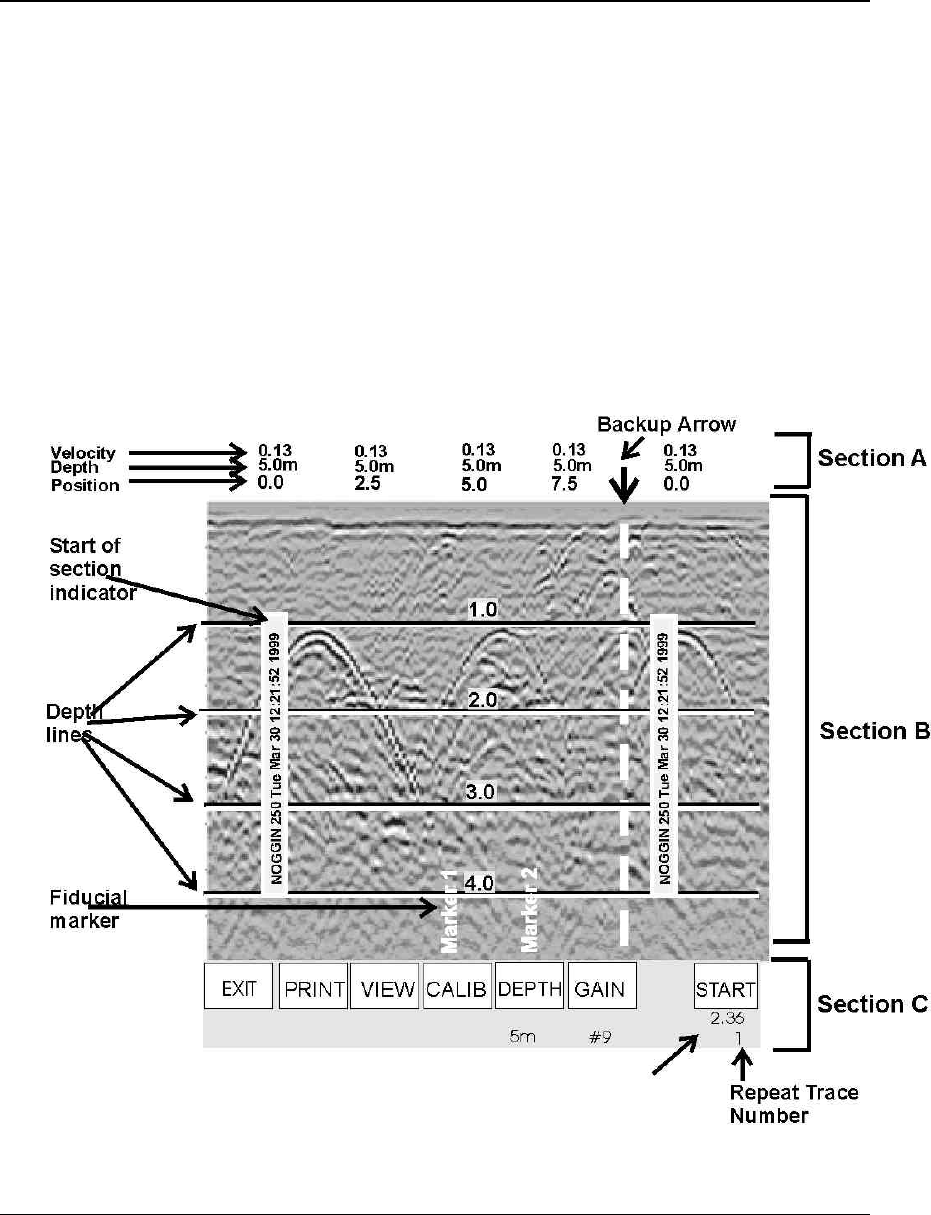
Smart Systems User’s Manual Version 1.1
21
5.2 Noggin Screen Overview
The Noggin screen is shown in Figure 5-1. It is divided into 3 sections. The very top
section (Section A) contains velocity, total depth and positioning information. The center
section (Section B) contains the actual data and the bottom section (Section C) contains
the menu.
Each screen of data is saved in the Digital Video Logger as an individual PCX graphics
file called a SPI file. Although each screen is saved as an individual file, these files can
be viewed together as a continuous chart up to 250 screens long. These data can be
viewed on screen (see Section 5.3.3), printed directly to a printer attached to the DVL or
transferred to an external computer (see Sections 5.3.2 and 5.6.1).
Figure 5-1: Noggin Data Acquisition Screen

Smart Systems User’s Manual Version 1.1
22
5.2.1 Section A - Data Parameters
Section A displays three items:
1) The total depth to the bottom of the data image in Section B,
2) The velocity used to calculate the total depth and the depth lines (see
Depth Lines in Section 5.2.2) and
3) The position indicator in meters or feet (depending on the odometer units
set, see Section 5.5.1 – Units).
Rather than displaying total depth and depth lines the user can select to display the total
time window in nanoseconds (see Section 5.5.1 - Units).
Note that it is possible to change the position label size (see Section 5.5.1 – Label Size).
5.2.2 Section B - Data Display
This section contains the actual data collected or replayed. The section also contains the
depth indicator lines, battery voltage indicator (which is visible each time you start), start
of section indicators, and any fiducial markers the user enters. See the sections below
for more details.
Depth Lines
Depth lines are horizontal labelled lines indicating the estimated depth. They are very
useful for getting depth estimates to features of interest in the data.
The positions of the Depth Lines are controlled by the current velocity value as well as
the depth selected. See Section 5.3.5 on selecting different depths and Section 5.8.1 for
more details on how depths are determined.
To display the correct depth, it is the responsibility of the user to calibrate the
system to the correct velocity of the material (see Section 5.3.4 on how to
calibrate the system).
Note that it is possible to change the depth units and the depth label size (see Section
5.5.1).
Battery Voltage Indicator
When the Start button is pressed, the current battery voltage will be displayed on the
extreme left side of the screen.
The voltage indicator can be helpful for identifying when the battery needs to be
recharged. If the battery voltage drops below 10.5 volts the DVL will cease to operate
and this monitoring capacity will not be available.
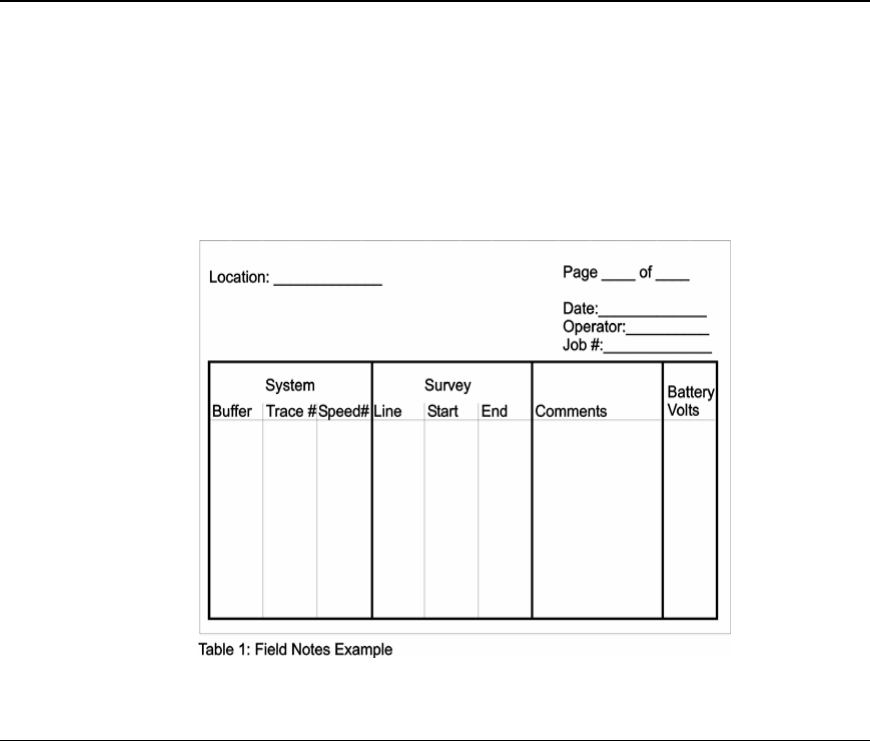
Smart Systems User’s Manual Version 1.1
23
Start of Section Indicator
Any time the Start button is pressed, the current date and time are written vertically on
the screen to indicate the start of a new section (see Section 5.5.1 on how to set time
and date on the DVL). The position indicator is also reset to zero. The current date and
time can be recorded in a field notebook along with the survey location to help the user
organize where each section of data was collected (Figure 5-2).
Figure 5-2: Example field notes
Fiducial Markers
A fiducial marker is text written vertically on the section at a specific position during data
acquisition. Adding these markers during data acquisition is useful for recording
significant positions or the positions of surface objects encountered during the survey.
The position and name of the object encountered at each marker can be recorded in a
field notebook. Then, when the data are reviewed, these markers are visible right on the
data section and can assist with data interpretation.
A fiducial marker is activated by pressing the A button on the DVL keypad during data
acquisition.
Smart Handle systems: On Smart Handle systems, it is also possible to add a fiducial
marker by quickly pressing the button on the Smart Handle during data acquisition.
The first time the A button (or Smart Handle button) is pressed, the text “Marker 1” will
be written to the screen at the current position. The marker number will then increment
each time it is pressed, for example, Marker 2, Marker 3 etc (see Figure 5-1).
Note that it is possible to automatically place a dashed vertical line at every position
label (see Section 5.5.1 – Odometer Markers).

Smart Systems User’s Manual Version 1.1
24
5.2.3 Section C - Menu
The bottom section contains the user menu selection and current program settings. This
menu is described in more detail in Section 5.3.
During data acquisition it also displays the current odometer position and the Repeat
Trace Number that indicates if the system is moving too quickly and reducing data
quality (see Section 5.4.1).
5.3 Noggin Menu Options
The default menu selection is divided up into 7 sections: Exit, Print, View, Calib., Depth,
Gain and Start. Each of these options is addressed below.
Execution of a menu item is done by pressing the key immediately below the menu item.
Pressing the key will change the setting for that menu item. For example, pressing the
key below the Depth menu item will start to cycle through the different depth settings
available.
5.3.1 Exit
This button will terminate the Noggin program and return the user to Noggin main menu.
The user can then run the Noggin again, run the demo program, change DVL settings,
download data to an external PC, delete data or return to the main menu (see Section
3).
Note that when the Start button is pressed and data acquisition begins (see Section
5.3.7), the Exit button turns into a Stop button (see Section 5.3.8). Data acquisition must
be stopped by pressing the Stop button before it is possible to exit from this menu.
5.3.2 Print Menu
This menu item allows the user to:
1) Print data images directly to an attached printer or,
2) Transfer one or more screens (or buffers) of data to an external computer
(PC) as a single PCX graphics file. This type of transfer is appropriate
when the user wants to transfer the data to an external computer for use
with third-party graphics software packages like Microsoft Paint and
Word.
Printing Data to an attached Printer
The Noggin data images can be printed directly to a few select, but common, printers.
The supported printers are HP LaserJet printers, most Epson printers and the Seiko
DPU5400 thermal printer. As well, any printer that can emulate these printers can be
used (see your printer’s User’s Guide for emulation modes available). For example,
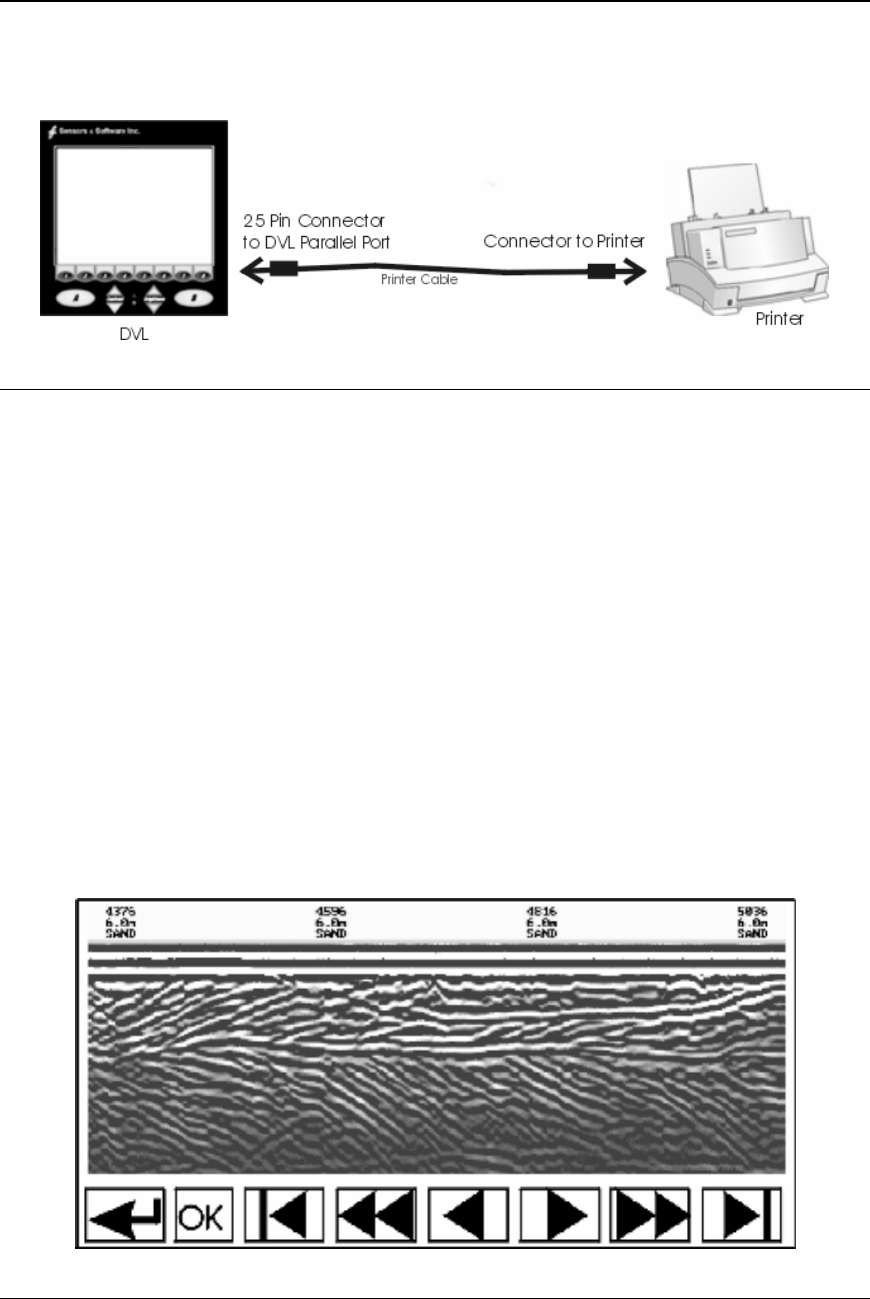
Smart Systems User’s Manual Version 1.1
25
Canon BubbleJet printers can usually be configured to emulate an Epson and most HP
printers will work using the Laser driver.
Figure 5-3: Attaching a printer to the DVL using a standard printer cable.
On the back of the DVL there is a standard 25 socket parallel port. A printer can be
attached to the parallel port on the DVL with a standard printer cable, just as you would
attach a printer to any computer (Figure 5-3).
Always power down the DVL before attaching a printer. This will prevent damage
to the parallel port.
On the Digital Video Logger, after the Print option is selected, the user must define the
section to be printed. The left edge of the page must be established first. This is done by
lining up the left edge of the Digital Video Logger screen with the edge of the plot
desired. Use the arrow buttons on the screen to move the section back and forth (Figure
4.1). A single arrow moves the image 8 pixels either right (4), or left (3). A double
arrow will move the image 640 pixels or 1 full page to the right (8) or left (7). A single
arrow with a vertical line will move the section either to the start (ψ3), or end (4ψ) of
the section. If the start or end of section button is pressed, the image will page through
one screen at a time. Data scrolling can be stopped by pressing any button. Once the
left edge is in place, pressing the OK button will lock the left edge of the plot.
Figure 5-4: Noggin Print Screen

Smart Systems User’s Manual Version 1.1
26
The right edge of the plot must now be defined the same as the left, however now using
the right edge of the Digital Video Logger screen. Note that the right edge cannot exceed
the left edge.
Next, select the type of printer attached (LASER for HP LaserJets and many other HP
printers, EPSON for Epson or Canon BubbleJet printers or SEIKO for the Seiko
DPU5400 Thermal printer). Text will appear on the bottom of the DVL screen indicating
the image is printing on the printer.
If an error occurs during the printing operation, press the A button to Abort. Try to
resolve the problem and try again. It may be necessary to turn the DVL off and power it
back on and try printing again.
When the print is complete the user is returned to the Noggin screen.
Transferring Data to an External PC
There are two ways of transferring data to an external computer. The first is to transfer
one or more screens (or buffers) of data as a single PCX graphics file. This method is
described in this section. The second way of transferring data files to an external
computer is to copy all the individual SPI (PCX) files from the DVL (see Section 5.6.1).
This method is useful when the user wants to view the data on an external computer
using the SpiView software. SpiView is available from Sensors & Software Inc.
The data transfer function can only be used after the parallel XFER cable has been
connected from the DVL to the external computer and after the WinPXFER
program has been installed on the external computer and run. Section 5.6.1
describes how to attach the parallel XFER cable and also how to install and run
the WinPXFER program.
Once WinPXFER has been run on the external computer, it is ready to receive data
image files from the Digital Video Logger.
On the Digital Video Logger, after the Print option is selected, the user must define the
section to be printed. The left edge of the page must be established first. This is done by
lining up the left edge of the Digital Video Logger screen with the edge of the plot
desired. Use the arrow buttons on the screen to move the section back and forth (Figure
4.1). A single arrow moves the image 8 pixels either right (4), or left (3). A double
arrow will move the image 640 pixels or 1 full page to the right (8) or left (7). A single
arrow with a vertical line will move the section either to the start (ψ3), or end (4ψ) of
the section. If the start or end of section button is pressed, the image will page through
one screen at a time. Data scrolling can be stopped by pressing any button. Once the
left edge is in place, pressing the OK button will lock the left edge of the plot.
The right edge of the plot must now be defined the same as the left, however now using
the right edge of the Digital Video Logger screen. Note that the right edge cannot exceed
the left edge.
Next, select a name for the image file from the options CART-1 to CART-4. As long as
the WinPXFER program is running on the external PC, the file will be transferred to the
current directory indicated by WinPXFER. When the data image file transfer is complete,